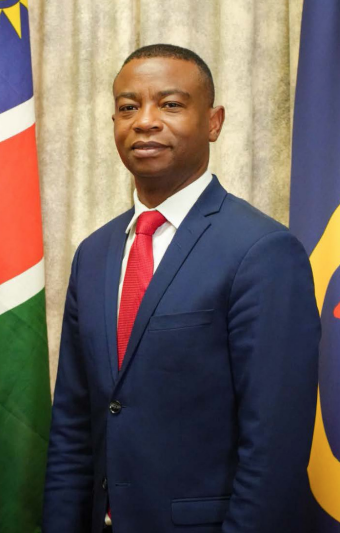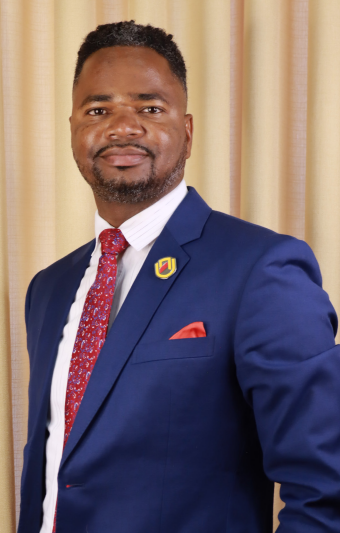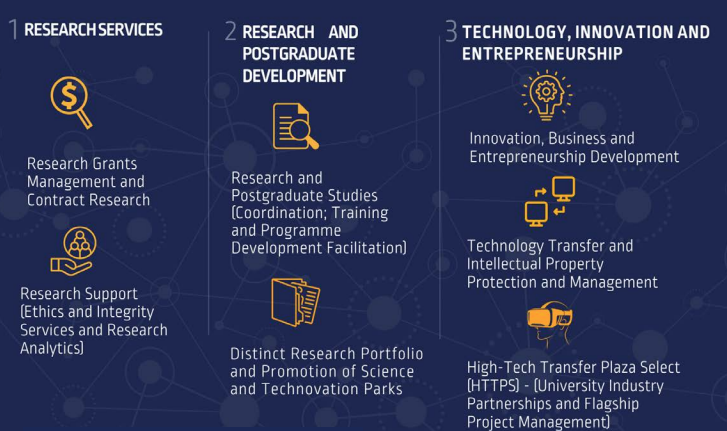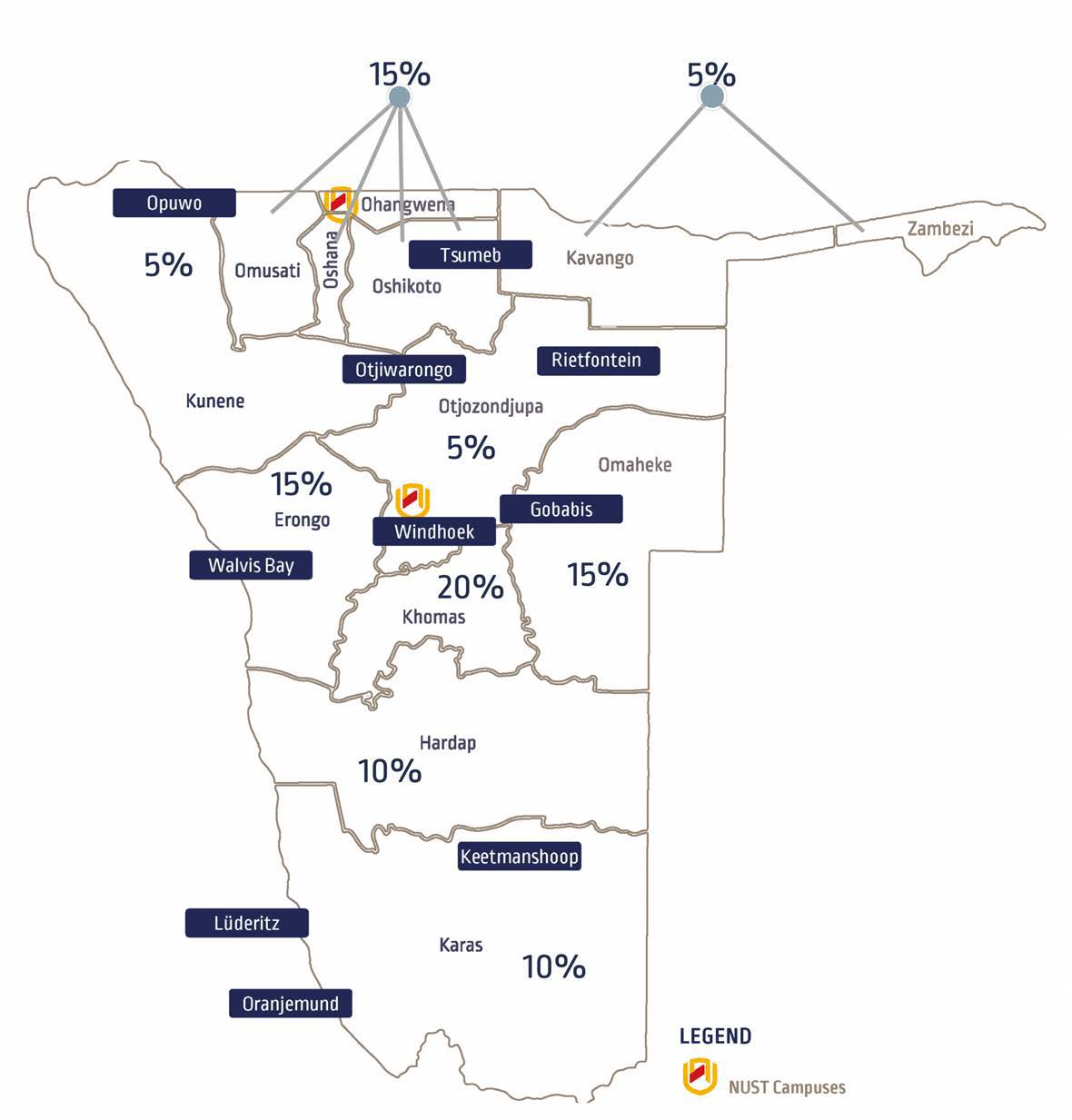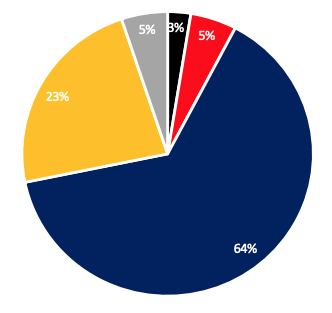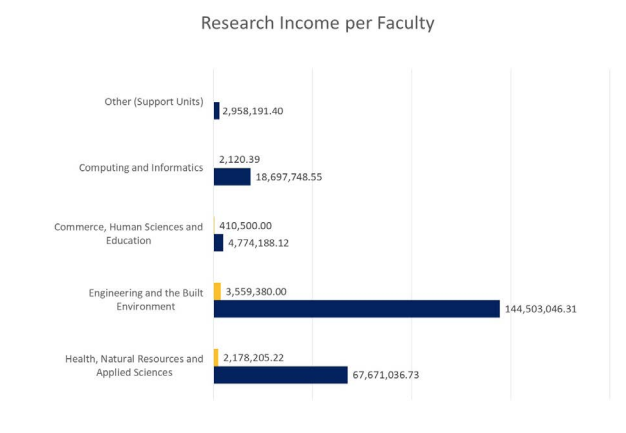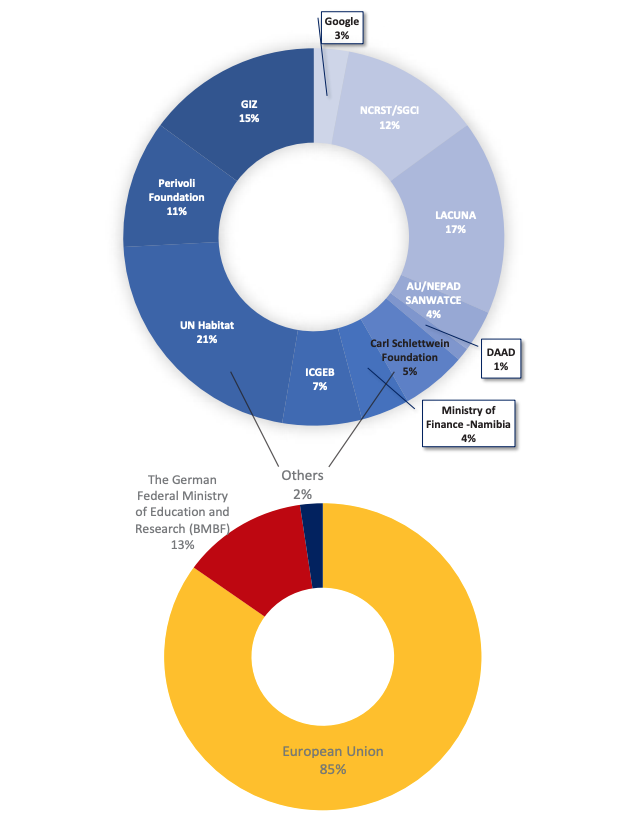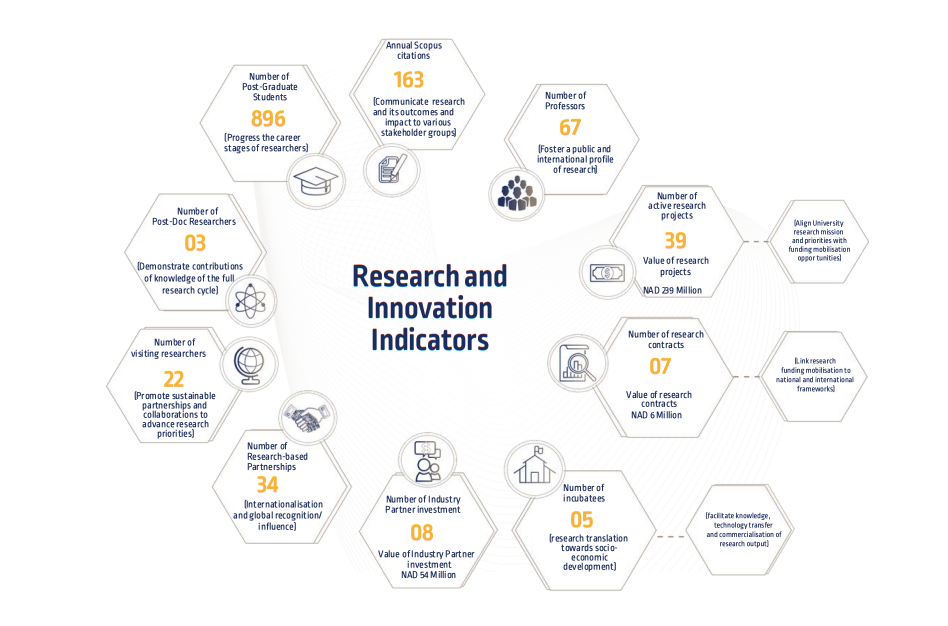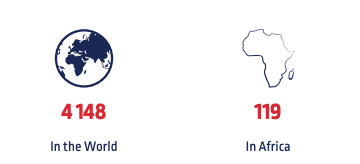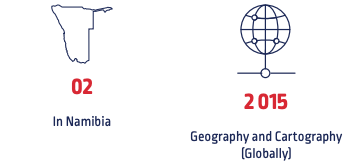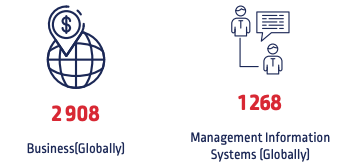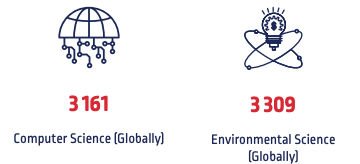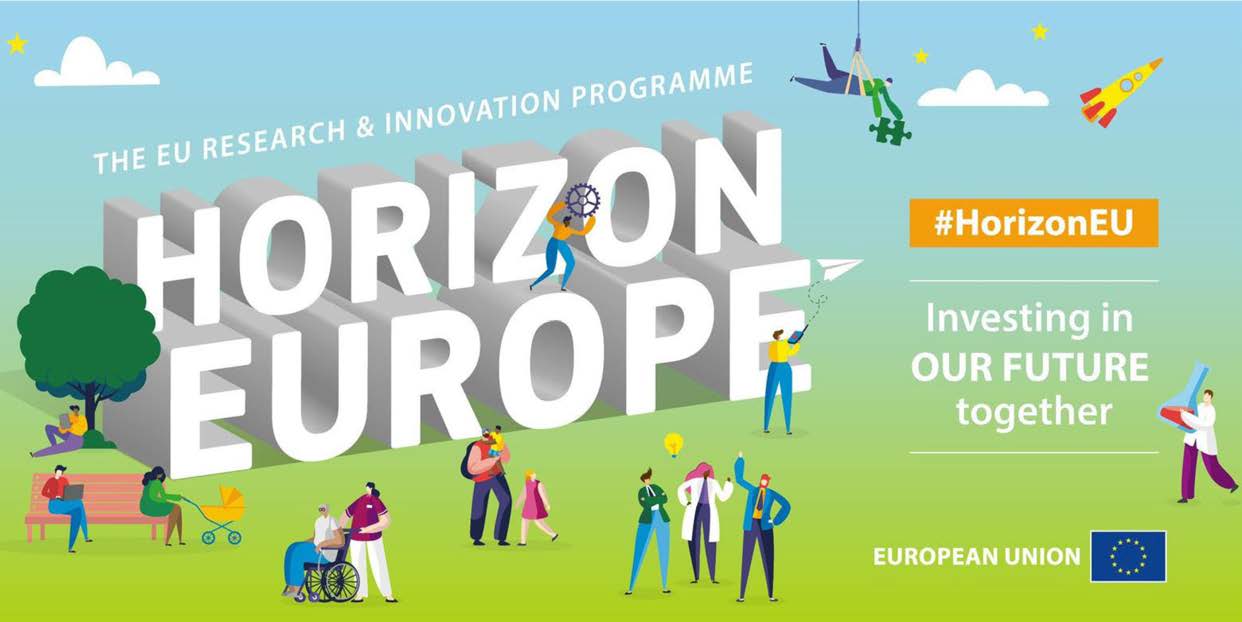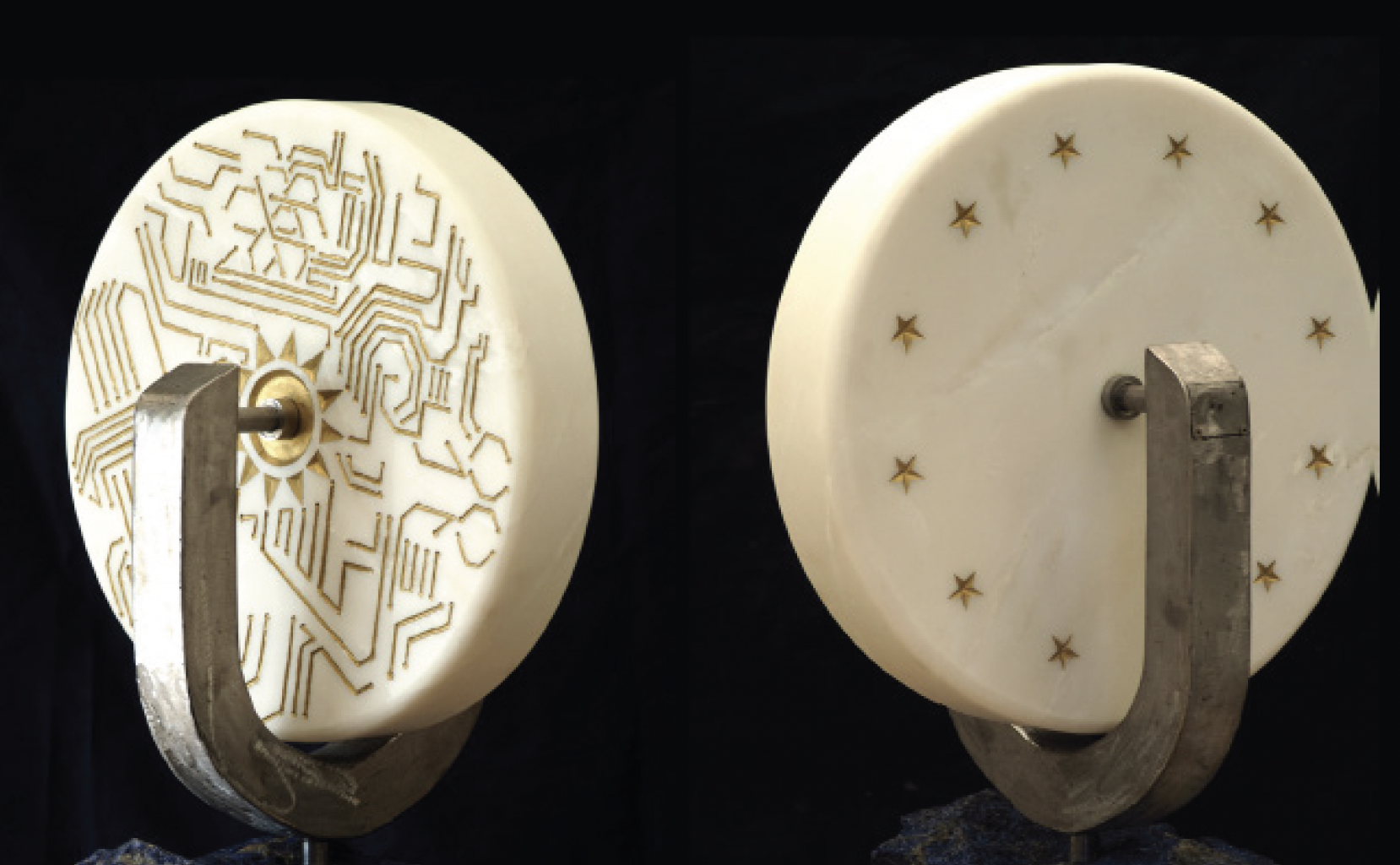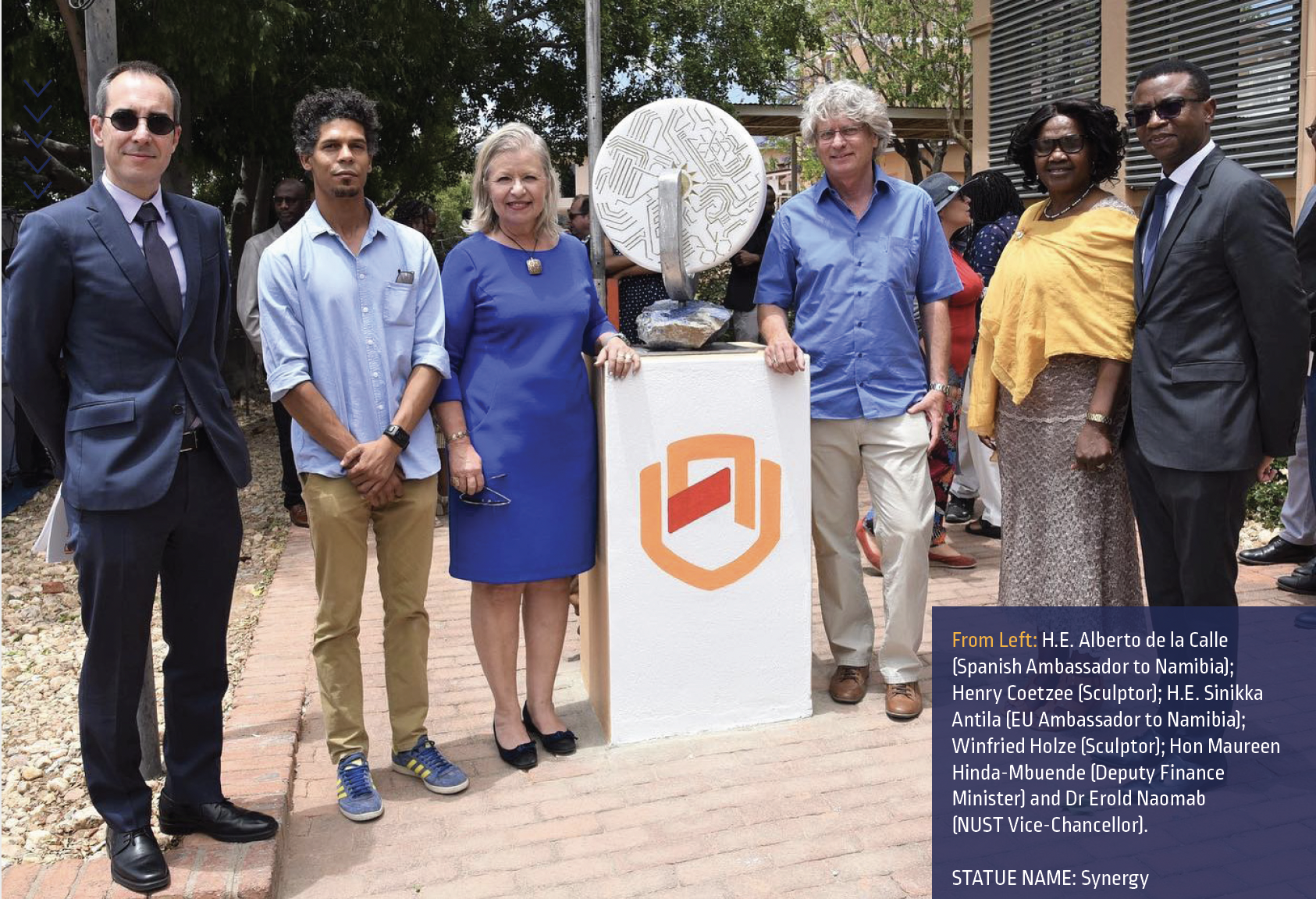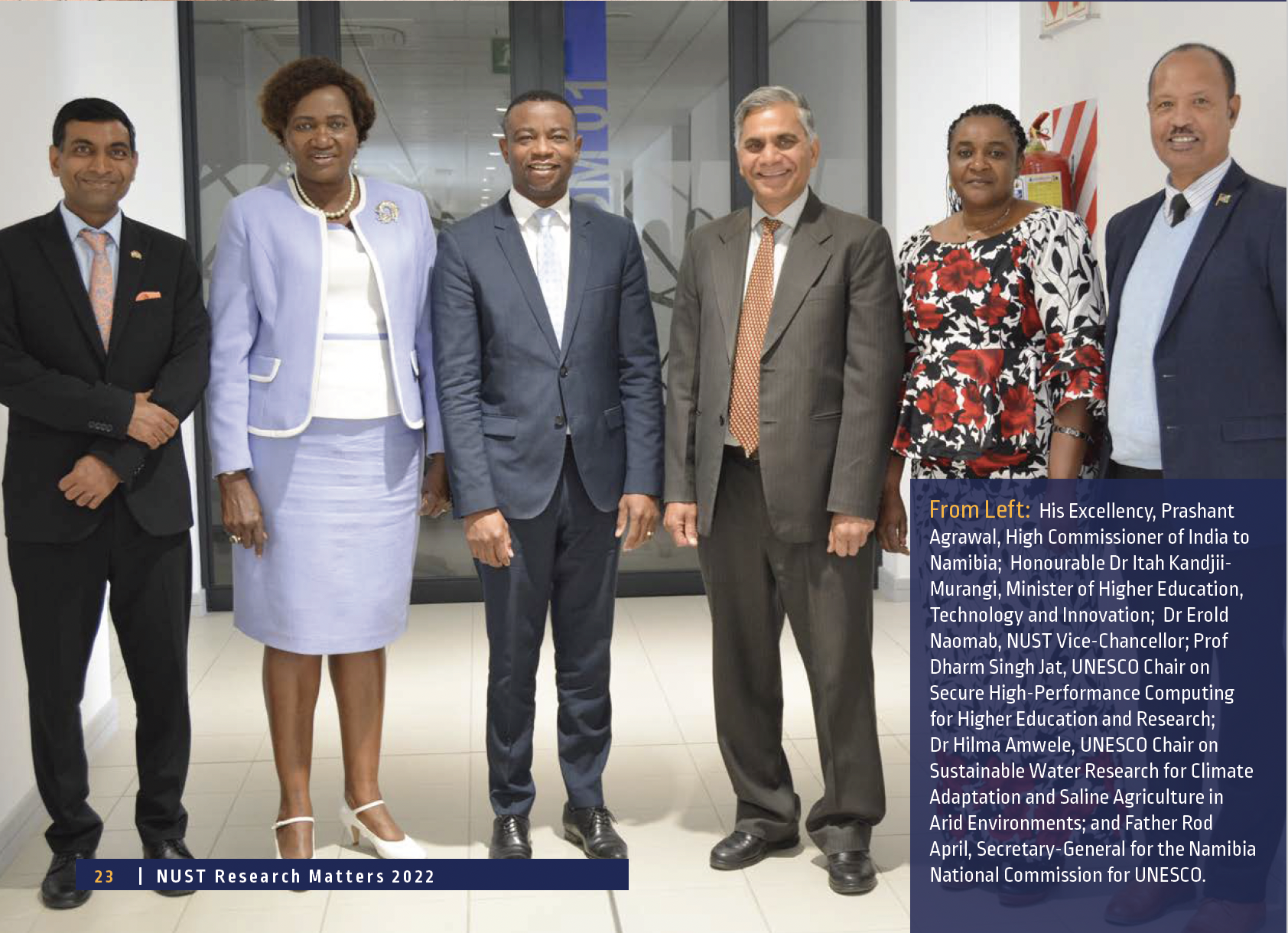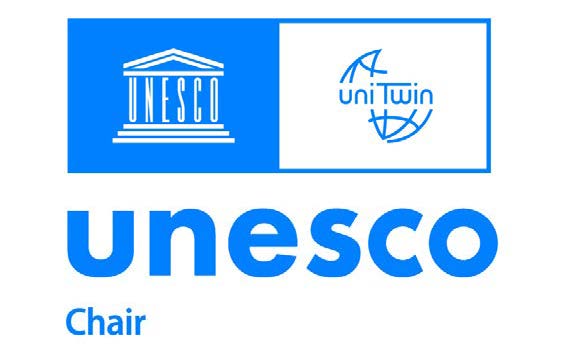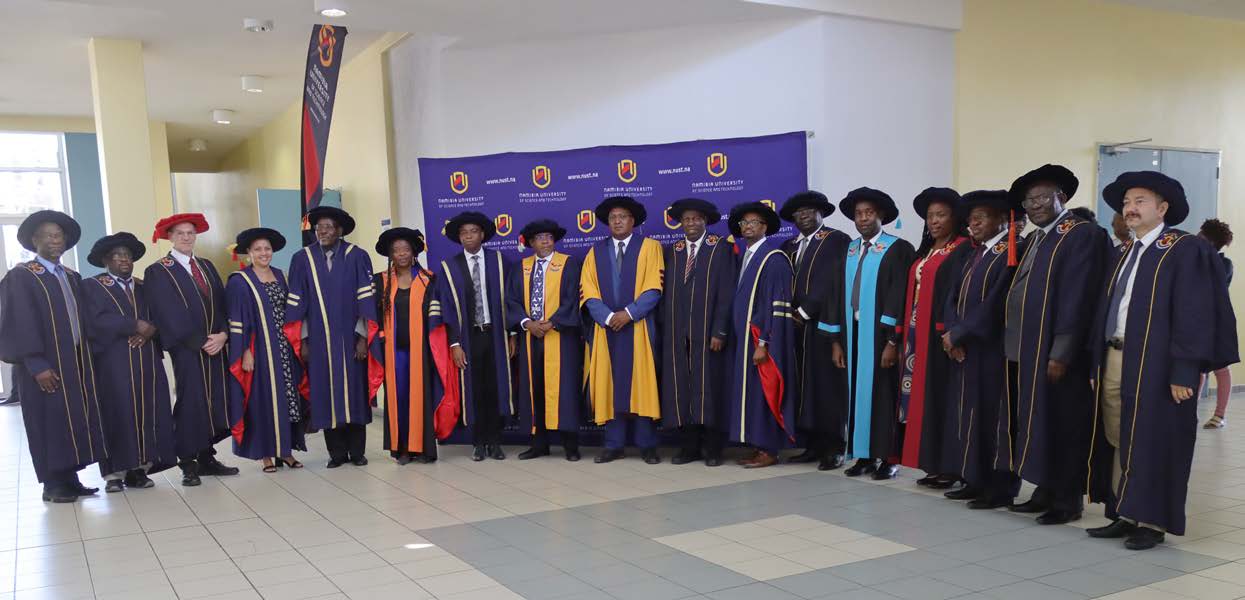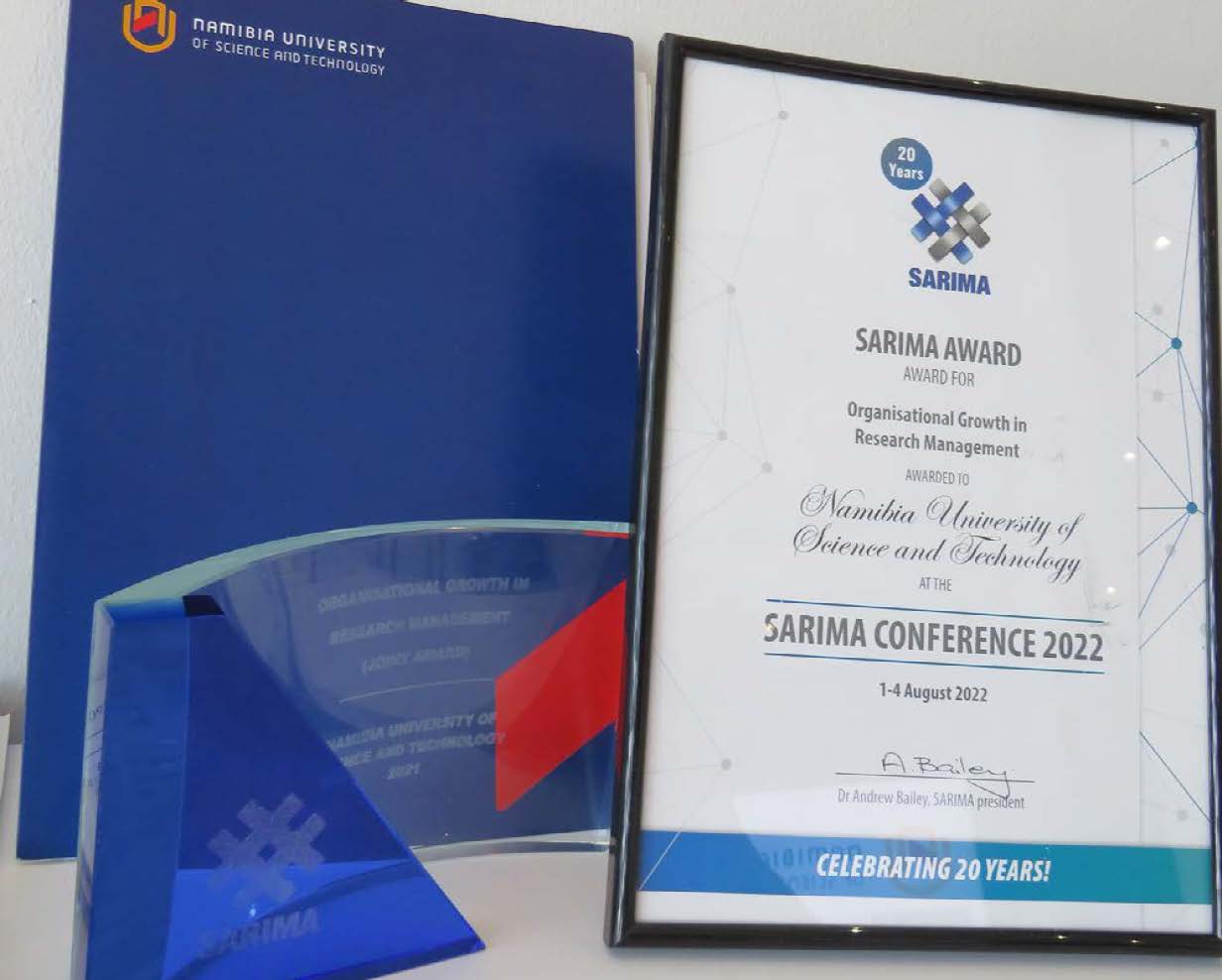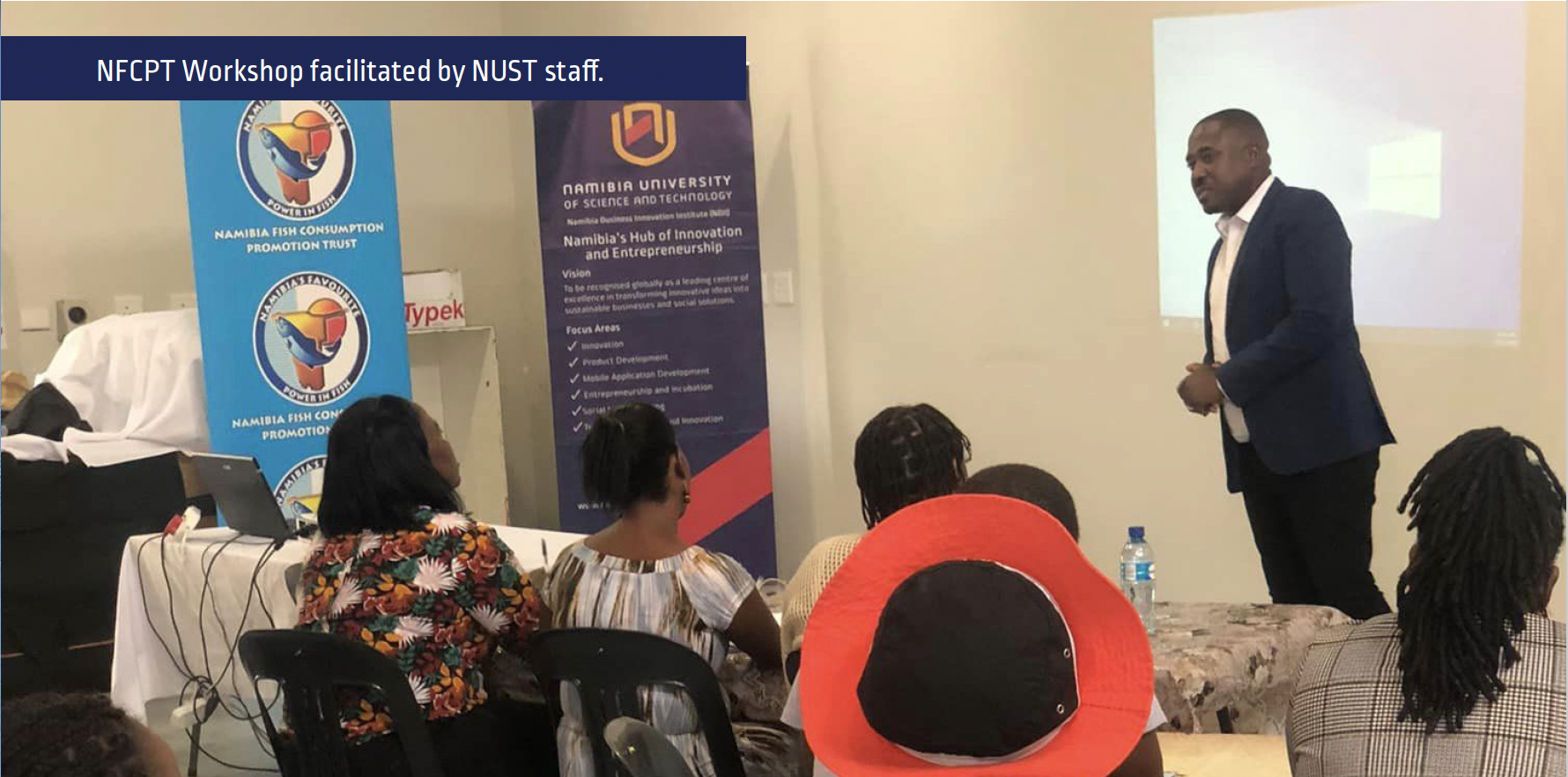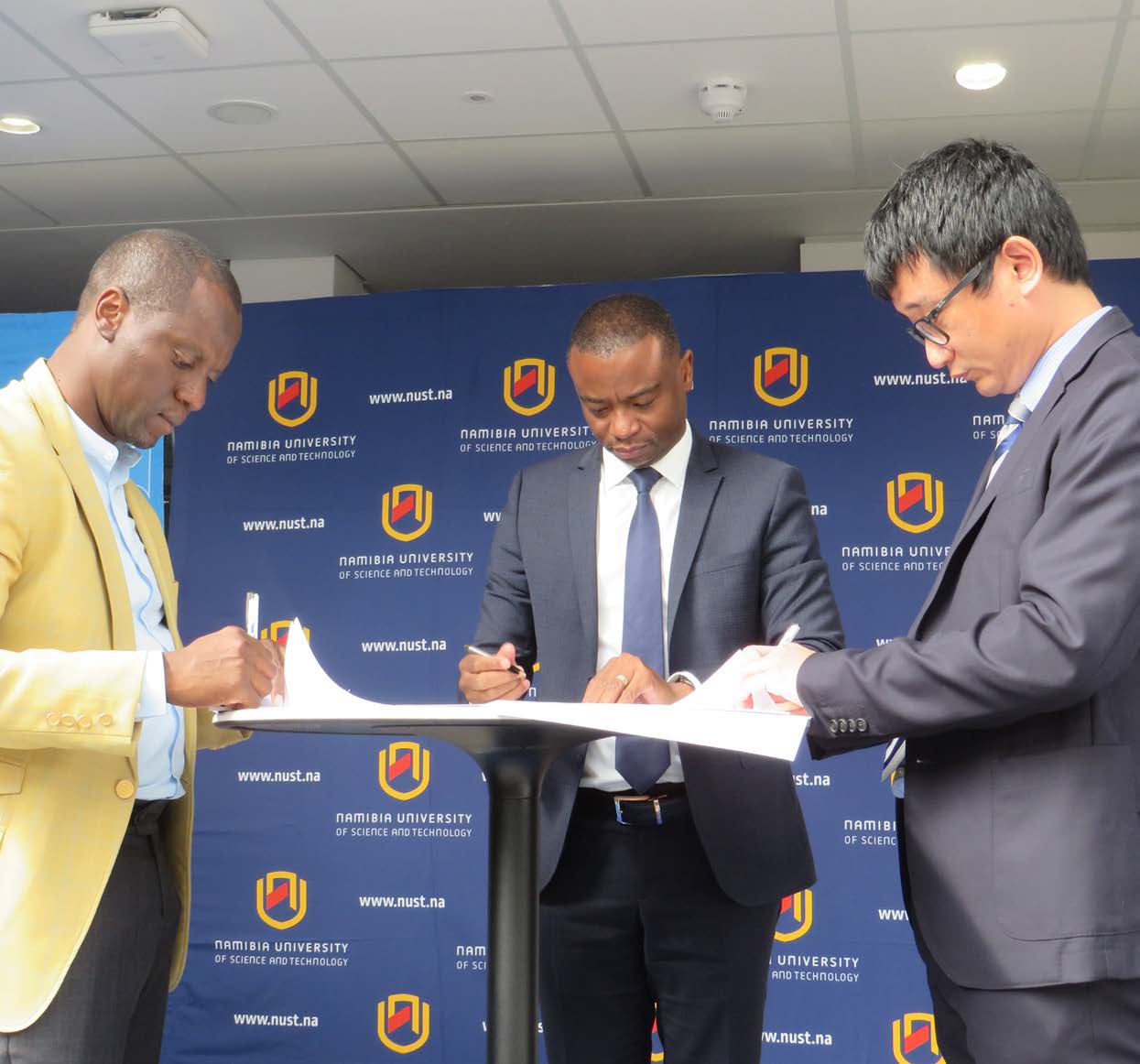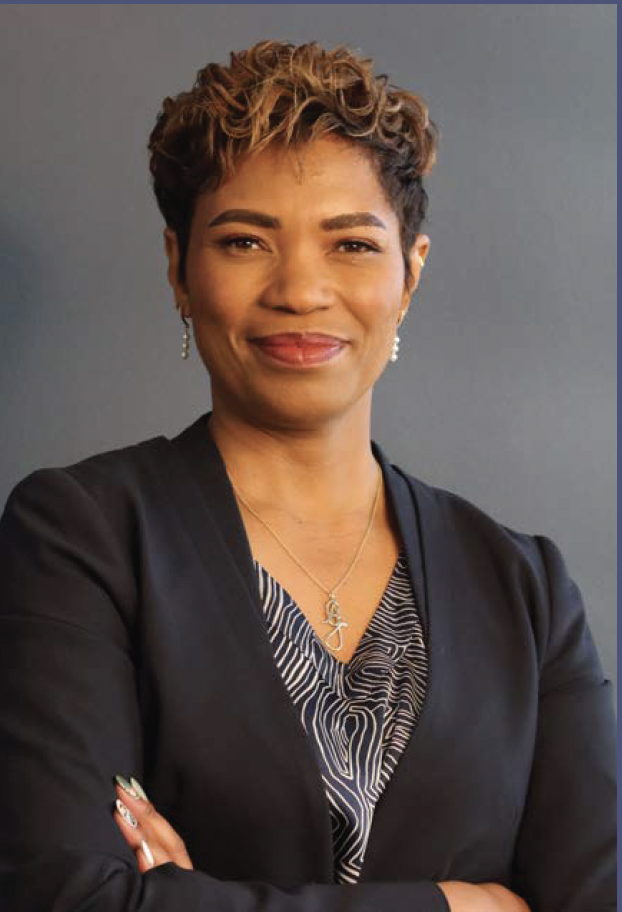Research Matters 2022
Driven by an ambitious vision to be a premier technological university known for knowledge creation, innovation, and entrepreneurship, NUST remains committed to growing the Science, Technology, Engineering and Mathematics (STEM) fields. Additionally, contributing towards the Green, Blue and Bio-Economy.
This is delineated in the institution’s Strategic Plan 2020-2025, along with various themes, goals, and initiatives. Key among them is to assume stewardship of science and technology and develop the human capital resources that are in support of national, regional and global priorities as outlined in the Sustainable Development Goals (SDGs) and the African Union’s Agenda 2063.
Understanding the needs of local society is critical for impact hence, stakeholder engagement and collaboration are critical success factors for reaching developmental goals in our capacity to meet the rapidly changing needs of society. They help us to stay abreast of local and global challenges, understand external priorities and expectations, and ensure our integrated teaching and research remain relevant.
Dr Erold Naomab
Vice-Chancellor
The promotion of a culture of innovation and entrepreneurship, underpinned by a well-established research base, in tandem with other components of our research and teaching landscape. This will assist us in transforming these research and innovation outputs into commercially viable and socially relevant products and services through the pursuance of internationalisation through strategic partnerships.
The University encourages trans-disciplinary research collaborations in the institutional defined areas namely; Water-Energy-Food (WEF) nexus, Climate Change and Natural Resources Stewardship, Green Logistics, Indigenous Knowledge Systems (IKS), and Sustainability and Digital Humanities. All areas have technology, innovation, and entrepreneurship as common denominators.
This report gives a glimpse of what transpired throughout the year in key research thematic areas.
Enjoy the read!
Dr Colin Stanley
Acting Deputy Vice-Chancellor: Research, Innovation and Partnerships
The Directorate of Research, Innovation and Partnerships (DRIP) encourages and stimulates collaboration across faculties, research clusters, institutes, centres, and disciplines. The aim is to harness synergies and stimulate convergence of the diverse knowledge base, thus generating a breeding ground for multi-disciplinary knowledge creation and technology development transfer. The latter results in the promotion of innovation and entrepreneurship across the university, primarily through the strategic consolidation of the Namibia Business Innovation Institute (NBII), Fabrication Laboratory (FabLab), and Innovation Design Lab (IDL).
Health & Climate Change
Digital Humanities
Indigenous Knowledge Systems & Sustainability
Water-Energy-Food Nexus
Natural Resources and Value Chain Stewardship
Contract Research
Research Income
*NCRST - National Commission on Research, Science and Technology
*SGCI - Science Granting Councils Initiative
*NEPAD - New Partnership for Africa’s Development
* SANWATCE - Southern African Network of Water Centres of Excellence
*ICGEB - International Centre for Genetic Engineering and Biotechnology
|
Faculty |
Peer-Reviewed Journal Articles |
Books |
Book Chapters |
Oral/Poster Conference Presentations | Technical Reports | Masters Graduate | Doctorate Graduates |
Others |
Total |
| Commerce, Human Sciences and Education | 46 | 3 | 17 | 18 | 1 | 125 | - | 6 | 216 |
| Computing and Informatics | 14 | - | 4 | 37 | - | 22 | 2 | 28 | 107 |
| Engineering and the Built Environment | 31 | - | - | 18 | - | 29 | 1 | 1 | 80 |
| Health, Natural Resources and Applied Sciences | 36 | 1 | 7 | 28 | 4 | 20 | - | 2 | 98 |
| Total | 127 | 4 | 28 | 101 | 5 | 196 | 3 | 37 | 501 |
| Faculty | Master's Degree | Doctoral Degree | Total |
| Commerce, Human Sciences and Education | 376 | 0 | 376 |
| Computing and Informatics | 144 | 24 | 169 |
| Engineering and the Built Environment | 170 | 23 | 193 |
| Health, Natural Resources and Applied Sciences | 117 | 42 | 159 |
| Total | 807 | 89 | 897 |
EduRank.org is an independent metric-based ranking of 14,131 universities from 183 countries. It utilises the world’s largest scholarly papers database with 83,166,817 scientific publications and 1,801,313,576 citations to rank universities across 246 research topics. Research influence in terms of rankings as follows:
Source (as at July 2023) : https://edurank.org/
The Alper-Doger Scientific Index (AD Scientific Index) is a ranking and analysis system based on the scientific performance and the added value of the scientific productivity of individual scientists. Furthermore, it provides rankings of institutions based on the scientific characteristics of affiliated scientists. The Index analyses academic studies from countries, universities/ institutions, and scientists by using numerous criteria to present results to be used for the evaluation of productivity and efficiency by individuals and institutions.
A total of 82 scientists currently and/or previously affiliated to NUST were assessed and the following are in the top 10 category.
Source (as at July 2023) : www.adscientificindex.com
| University/Institution Rank | Country Rank | Region Rank | Name | Field | H Index |
| 1 | 5 | 1 921 | Diptiranjan Sahu | Natural Sciences/Physics | 29 |
| 2 | 7 | 3 299 | Heike Winschiers-Theophilus | Computing | 24 |
| 3 | 8 | 3 405 | Benjamin Mapani | Engineering and Technology/Earth Sciences | 24 |
| 4 | 9 | 3 504 | Edosa Omoregie | Agriculture and Forestry/Fisheries | 23 |
| 5 | 10 | 3 591 | Michael Sony | Engineering and Technology/Chemical Engineering | 23 |
| 6 | 13 | 4 747 | Uchendu Chigbu | Land and Property | 21 |
| 8 | 22 | 7 386 | Michael Mutingi | Healthcare Operations | 17 |
| 9 | 23 | 7 982 | Percy Chimwamurombe | Medical and Health Sciences | 17 |
| 10 | 24 | 8 098 | Rakesh Kumar | Natural Sciences/Mathematics | 17 |
| 12 | 28 | 9 066 | Ben Strohbach | Natural Sciences/Biological Sciences | 16 |
Pivotal to the university’s research and innovation strategy is building capacity under research themes (or clusters) based upon a demonstrated track record, excellence and discipline expertise, including international standing and collaborations. The Research themes create opportunities for interdisciplinary research activity on global, societal and local needs.
The strategically defined themes, established through a consultative process, are described below, with highlights from related projects and links to the United Nation’s Sustainable Development Goals (SDGs).
The Southern African Science Service Centre for Climate Change and Adaptive Land Management (SASSCAL) Graduate Studies Programme in Integrated Water Resources Management (SGSP-IWRM)
The SGSP-IWRM is a three-year PhD academic programme embedded in SASSCAL’s long-term objective of building regional thematic Centres of Excellence within selected academic institutions across all SASSCAL Member States.
The objective of the programme is the development and deployment of an innovative and excellent regional collaborative education and research programme in different specialisations under the theme of Integrated Water Resources Management. The research component is complemented by selected tailor-made short courses to strengthen the students in new techniques such as geospatial analytical skills, programming and the use of models in data integration and analysis.
A SASSCAL Research Chair on Water Resource Quantity and Availability was awarded to Prof Ditiro Benson Moalafhi, during a Special SGSP Session at the 23rd WaterNet Symposium in South Africa, held under the theme: Advancing the Regional Water Security Scientific Agenda through Inter/Multi/Transdisciplinary Research. Prof Moalafhi is based at the Botswana University of Agriculture and Natural Resources (BUAN).
During the Symposium, eight SGSP-IWRM students presented papers.
The platform enabled the doctoral candidates to engage established academics and practitioners in the water sector.
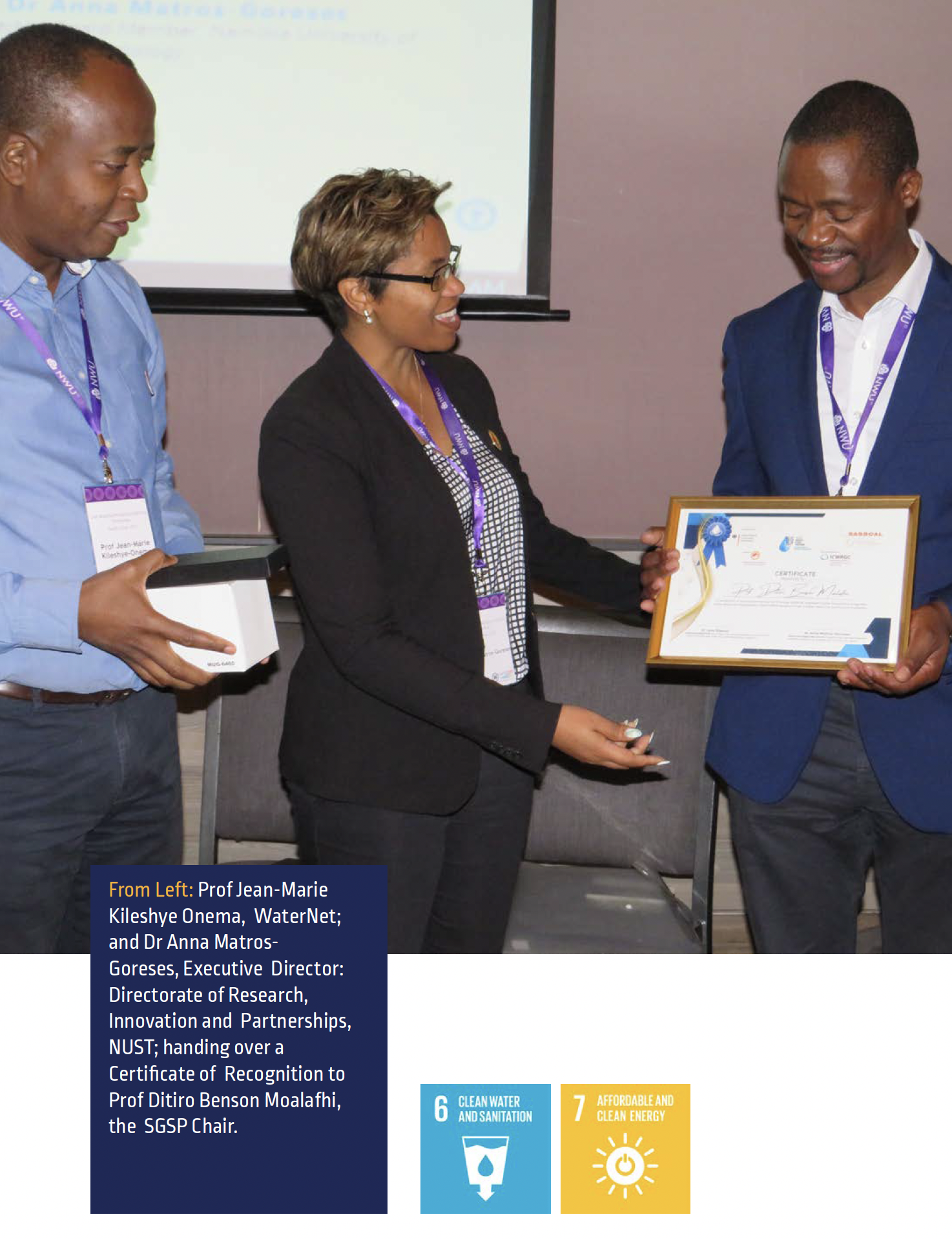
Name of Student Presenter |
Title of Abstract |
|
Muumbe Lweendo |
Changing Hydro-Cimatic Regimes and Planning Tools for Climate Resilient Development Pathways |
|
Otlaadisa Tafila |
Geological Influences on Groundwater Flow in the Okavango Delta Area |
|
Catherine Tlotlo Kerapetse |
A Conceptual Review on Modelling Surface-groundwater Interactions in Semi-arid Areas |
|
Chiamba Chiteculo Canivete |
Strategy for the Implementation of Building Information Modeling in the Integrated Water Resources Management in Angola |
|
Jimmy Katambo |
Applications of Artificial Intelligence for Water Resources Management |
|
Sydney Sichilima |
Application of Water Quality Index and Geo-Spatial Assessment Within Vulnerable Shallow Aquifer System in Peri-Urban Area of Zambia – A Case of Mulenga Compound |
|
Ofentse Moseki |
Assessment of Rice Water Use Efficiency and Productivity in Semi-arid Conditions of Namibia |
|
Maurício Honorato Clemente |
Modelling of Phosphorus and Nitrogen Concentrations in the Cubango River, Okavango Zambezi Basin |
Moreover, following a consultative process, in order to determine the need and demand for the proposed PhD programme in IWRM, to be hosted by the Faculty of Engineering and the Built Environment, an online needs assessment survey questionnaire was developed. It was distributed to various stakeholders in Namibia and other SADC countries. It is evident that the needs analysis survey and consultative workshops regarding the proposed programme yielded positive responses and tremendous support from different stakeholders in Namibia and beyond.
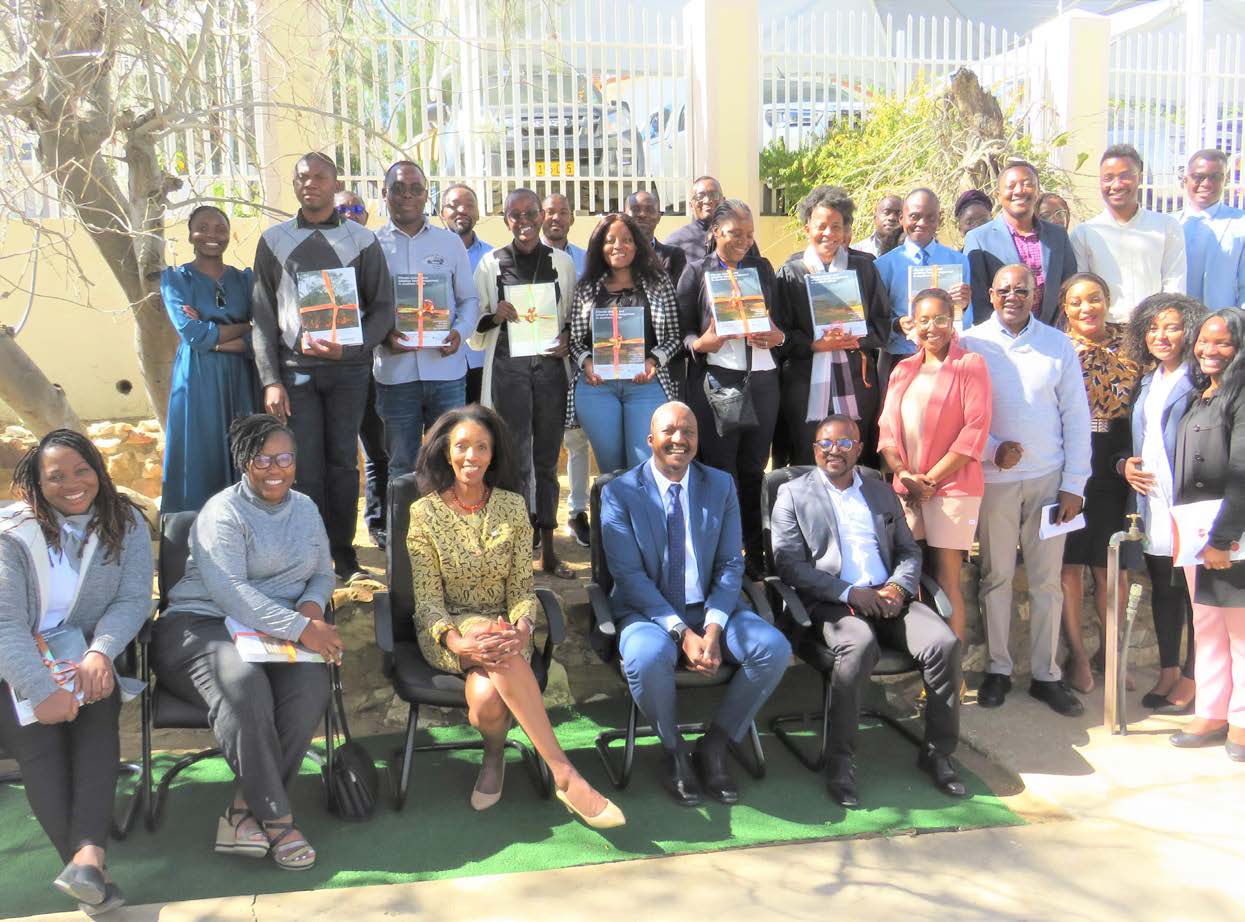
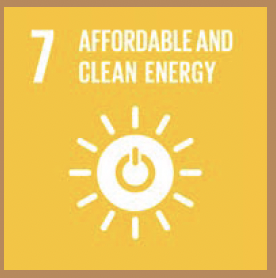
SESA is a European Union-funded Horizon 2020 project that aims to provide energy access technologies and business models that are easily replicable and generate local opportunities for economic development and social cohesion in Africa. The project has been designed to combine innovative energy access solutions for a range of applications in both urbanised and rural contexts in Africa and will focus on testing, validating, and replicating those energy innovations through co-developed demonstration actions.
The trips to Donkerbos and Otjisa, and the activities thereof, focused on understanding the local context from a market and technical perspective, identifying energy infrastructure and exploring novel and innovative green energy possibilities that expand green energy use beyond the established use cases.
During the above endeavours, a range of approaches, methods, and techniques such as Community-based Co-design, Futuring and Design fiction were pursued to appropriately and creatively engage and design with community members. This involved exploring rural game possibilities, cultural robots, virtual reality and evaluation of emerging technology within a current and future cultural and traditional premise.
This resulted in the development of a community hub design for Donkerbos as part of a collaboration with NUST’s Architecture Department and a locally renowned architect, in addition to the alignment and realignment of emerging technology in rural indigenous contexts. Overall, these outcomes have enhanced and will expand technology innovation in rural areas, with additional innovation and technology design possibilities and approaches envisioned.


NUST, together with five research institutions, received a project grant valued at approximately N$52 million from the German Federal Ministry for Education and Research (BMBF). The funding is for a project known as InfoRange, which aims to increase efficiency in rangeland-based livestock value chains through machine learning and digital technologies.
Rangeland-based livestock production is a major land use system that contributes between 15 and 60 percent of the agricultural GDP in eastern and southern African countries. However, site-specific information on the condition and intensity of use of rangeland resources is rarely available or accessible to herders in real time.
The project thus cuts across the agriculture and digital technologies sectors, taking a multidisciplinary approach, which is reflected in the diverse expertise among the researchers, which includes staff and PhD students.

The primary objective of the project is to develop EU-Africa partnerships and ensuring a responsible sourcing of minerals for the European industry. This is achieved while providing for a sustainable local co-development in the best Environmental, Social and Governance (ESG) conditions and creating a long-term business environment for European and African companies. AfricaMaVal focuses on the minerals and metals presented in the Fourth list of Critical Raw Materials for the EU, as well as on Copper (Cu), Nickel (Ni), Tin (Sn) and Manganese (Mn) that are particularly pertinent considering Africa’s geological potential and their critical status in the digital and energy twin transitions. In this proposal, an “Extended Critical Raw Materials” list (ECRM) will be used.
Partners: Bureau de Recherches Geologiques et Minieres, (France), EIT Raw Materials GmbH, (Germany), Bundesanstalt fuer Geowissenschaften und Rohstoffe (Germany), Association of Women In Mining in Africa (AWIMA) (Ghana), LGI Sustainable Innovation (France), International Raw Materials Observatory AISBL (Belgium), Southern African-German Chamber of Commerce and Industry (South Africa), Eurogeosurveys - EGS, (Belgium), Minerals Africa Development Institution (Uganda), Laboratorio Nacional de Energia e Geologia i.p. (Spain)

SteamBioAfrica demonstrates superheated steam processing of invasive woody biomass into clean burning biofuel and water in rural Namibia. Operating at an industry relevant scale (250kg/hour throughput) for over one year, SteamBioAfrica validated this biofuel with domestic and industrial customers in Namibia, Botswana, and South Africa. The project prepared sustainable and inclusive business plans to justify post project investment in large scale replication that will result in economic impact, and jobs across the region. The objective was to validate the superheated steam biomass processing as viable and sustainable source of large scale, clean burning, secure and affordable energy across Southern Africa.
Partners: Fraunhofer Institute for Interfacial Engineering and Biotechnology IGB (Germany), Heckmann Metallund Maschinenbau GmbH (Germany), Network New Europe Limited (United Kingdom), Comercial e Industrial Aries (Spain), Sveriges, Lantbruksuniversitet (Sweden), Fundacion CIRCE (Spain), University of Strathclyde (United Kingdom), Normag Labor- und Prozesstechnik GmbH (Germany), Urbion (Spain), Manrochem (United Kingdom).

NUST is coordinating the implementation of the FRAME Project in partnership with University of Buea (Cameroon), University of the Free State (South Africa), University of Hawassa (Ethiopia), Kwame Nkrumah University Science and Technology (Ghana) and University of Twente (The Netherlands). FRAME stands for Fostering Research and Intra-Africa Knowledge Transfer through Mobility and Education.
The project is part of the Intra-Africa Academic Mobility Scheme Initiative funded by the European Commission through the Education, Audiovisual and Culture Executive Agency (EACEA). The scheme supports higher education cooperation between countries in Africa and aims at contributing towards national capacity development for food, water and energy security.

Virtual Reality (VR) applications have gained in popularity, meanwhile expanding their use contexts to many different fields. Recent developments in VR headsets, with optical-based tracking, such as the Oculus Quest 2, support hand gesture-based interactions. However, currently a very limited repository of implemented gestures exists.
With the aim of designing VR applications for diverse user groups, an inclusive and participatory approach to the development of early stage technologies are used, such as VR gesture interactions. In collaboration with members of the Ju/’Hoansi community in Donkerbos, a gesture-controlled VR application of a hunting story, as told by the elders in the village was created. It was demonstrated in the field by an elder and youth, as well as 3D models and scenes described and designed by community members and interpreted by the researchers.
The story has been implemented in VR using the Unity game engine. The application consists of a number of scenes, where the user progress in the story, either through object interactions, or through gesticular interactions with the non-player characters (NPCs), using their hands only. The VR application is being validated by community members in Donkerbos. An analysis of user immersion, expectation satisfaction and observed gesture use will guide further research and developments of such systems.
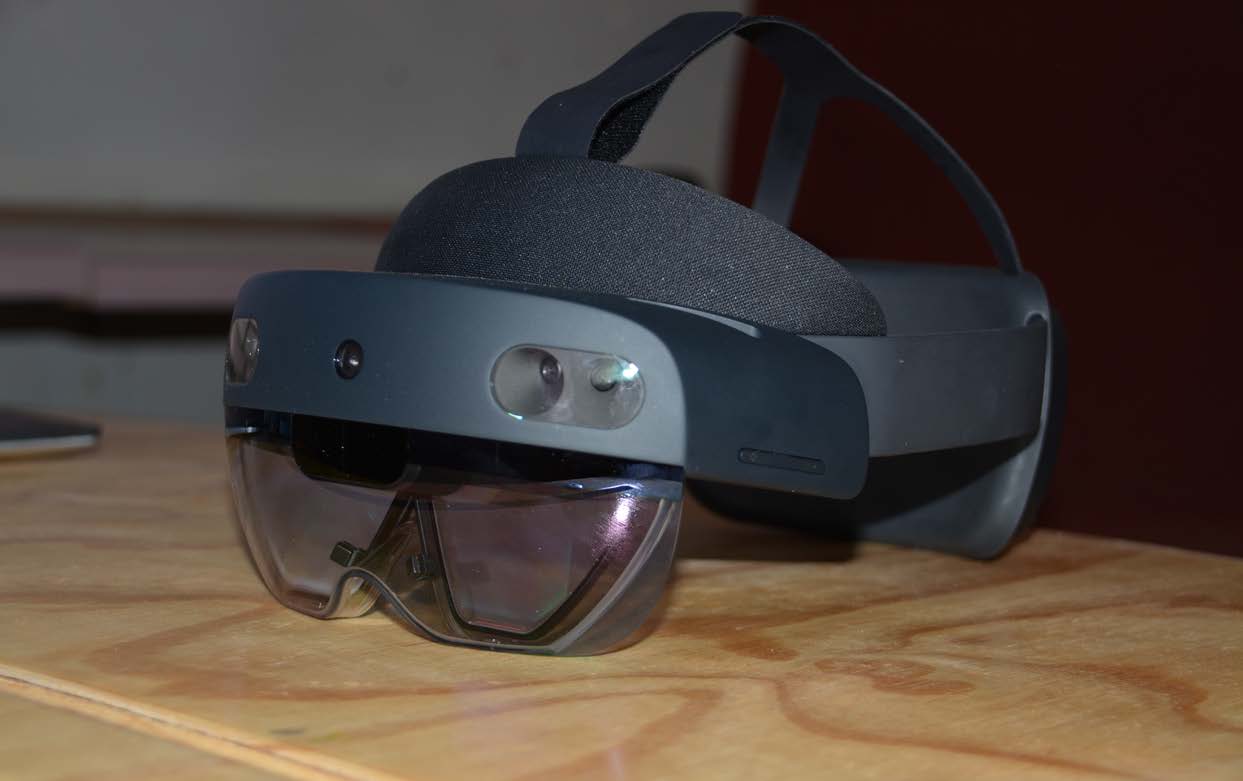
During a one-week workshop at People’s Primary School, Windhoek, Prof Heike Winschiers-Theophilus and Ms Itenge from the Academic Development and Support Unit, facilitated a co-designing session where participants explored 3D livestreaming technology to explore the new 3D live streaming technology using the Microsoft Holo Lense and Lidar technology (laser cameras).
The workshop was part of a four-year Academy of Finland funded project, under the leadership of Prof Erkki Sutinen (Future Tech Lab, Windhoek Campus, University of Turku) in partnership with an international and interdisciplinary research team. “This immersive technology will connect people across continents, with a feeling of being present and together, while being in remote places”, stated Prof Sutinen enthusiastically.
Dr Naska Goagoses, (Carl Von Ossietzky University of Oldenburg), the educational psychologist on the team, ensured that pedagogical frameworks and constructs, such as academic engagement, are embraced in the design of the technology to facilitate remote presence education. “Although the technology is in its infancy, it is of outmost importance to include Namibian students and teachers, in this early stage technology development to ensure local needs and ideas influence future development and global edutech trends,“ emphasised Prof Winschiers-Theophilus. The teachers and students who participated in the workshop, provided valuable suggestions of which some will be implemented by the software development team, led by Dr Nicolas Pope (University of Turku).
Visit https://sites.utu.fi/bittip/ or https://youtu.be/9eVA52Ioncg
In a time where primary education has experienced its greatest uncertainty due to a global pandemic, 62 learners from three local primary schools in Namibia, Finland and Malaysia respectively, jointly designed a new on-line learning space for children throughout a number of teleconferencing sessions. The project is a result of a transdisciplinary international long-term partnership between computer science and educational psychology researchers from NUST, University of Turku Finland, University of Technology Sarawak (UTS), Malaysia and Carl von Ossietzky Universität Oldenburg (COUO), Germany.
The research team recognised the absence of suitable on-line platforms for primary learners as well as a lack of involvement of children from different continents in collaborations of new educational technology developments. Children co-designing on-line platforms for children across the world provides solutions for the exchange of local perspectives in global learning ecologies, setting new trends during and after COVID-19, for inclusive and diverse education systems. Over a period of 6 months, learners from each school, namely Woodlands International School Sibu, Malaysia, People’s Primary School, Windhoek Namibia and Pääskyvuori School, Turku Finland, respectively, met bi-weekly to create design suggestions for an on-line learning space. Two representative learners from each school met bi-weekly on-line with the learners from the other continents to explore, exchange and synthesis design concepts, which were then prototyped by computer science students from NUST and UTS. The created system was successfully used to facilitate a final session with all learners from the three continents, facilitated by the educational psychologist from Germany.
Providing scientific input into conservation challenges
NUST’s Biodiversity Research Centre (BRC) was established to enhance multi-disciplinary faculty and student research to provide scientific input for the conservation challenges faced by the country. As a partner of the Ministry of Environment Forestry and Tourism and member of the Namibian Chamber of Environment, the Centre is fast establishing itself as indispensable to support biodiversity conservation and associated rural livelihoods. By including aspirant scientists through NUST’s Master’s and PhD programmes there is an added benefit of mentoring, together with the biodiversity industry, the next generation to support sound decision making around biodiversity (such as wildlife) and community prosperity. This would not be possible without support from a global network of academic, conservation and donor organisations.
The centre secured PhD and Master’s bursaries for Namibian students during the year under review. Some noteworthy international partners which either co-supervise students or participate in our research are St. Andrews University and London School of Economics in the UK, the Smithsonian Institution in the US, and the United Nations University. In collaboration with the Giraffe Conservation Foundation (GCF) , the BRC formed a partnership with Etosha Heights Private Reserve to develop a long-term holistic conservation and education science programme. Etosha Heights has rewilded over 60,000 hectares of degraded farmland to a haven for wildlife adjacent to the iconic Etosha National Park in Namibia. The site has also been a base for the ORYCS project where together with Potsdam University and the University of Namibia (UNAM), it continues to track the movements of wildlife between the national park and neighbouring areas, and the effect of these movements on communities and the ecosystem as a whole. In 2022, lions and elephants were species added to the suite of animals being tracked. This work resulted in four peer-reviewed scientific journal articles in 2022.
The BRC has, through a Ministry of Environment, Forestry and Tourism-GIZ funded project, conducted research and training regarding Namibia’s biodiversity economy. The research considers the value of biodiversity for livelihoods of communities, as well as the costs and benefits of conflict causing animals such as elephants and predators. This has also provided an opportunity to engage communities affected by conflict with elephants and to co-design and early-warning systems using satellite telemetry and the Earth ranger platform.
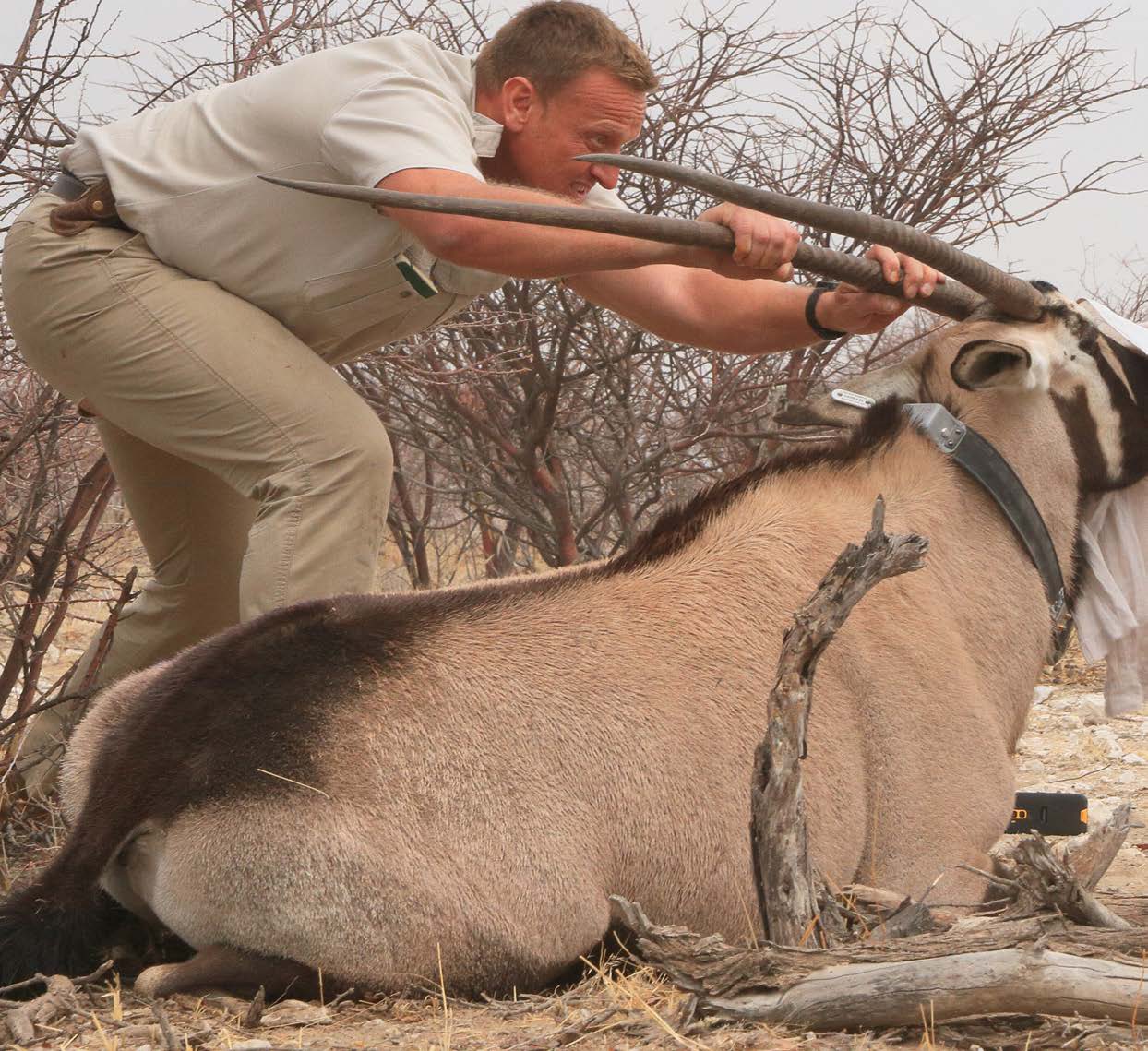
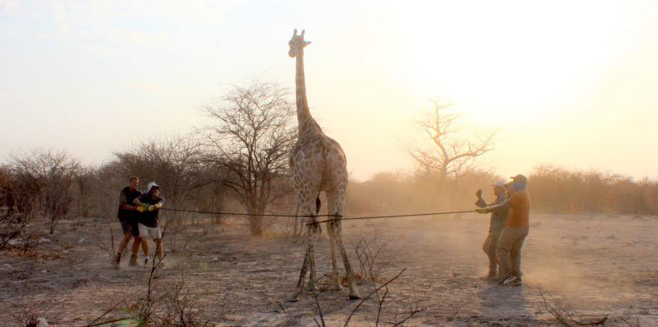
The longstanding partnership between the Institution and the European Union, began in 2002 with the development of the NUST Hotel School. It is the epitome of joint and collective effort towards mutually beneficial developmental objectives. Over the past two decades, NUST and the EU have collaborated on no less than 48 projects with a total value of over N$926 million (approx. €52m). The projects range from research, cultural spheres and staff/student exchanges.
The longstanding partnership between the Institution and the European Union, began in 2002 with the development of the NUST Hotel School. It is the epitome of joint and collective effort towards mutually beneficial developmental objectives. Over the past two decades, NUST and the EU have collaborated on no less than 48 projects with a total value of over N$926 million (approx. €52m). The projects range from research, cultural spheres and staff/student exchanges.
|
Total |
48 |
€ 51,772,693.26 |
|
Developmental Focal Areas |
Number of Projects |
Total Value |
|
Institutional and Individual (mobilities) - excludes Hotel School Investment |
13 |
€ 12,707,766.67 |
|
Research * |
31 |
€ 34,271,045.60 |
|
Cultural |
04 |
€ 4,793,880.99 |
*many of the projects are cross-cutting in nature, especially research projects contributing to both to institutional, individual and cultural development aspects.
Internationalisation is at the core of the collaboration and as such, the various partnerships established over the period within the EU Member States, both at University and Industry levels, provide evidence of mutually beneficial engagements. The two decades of partnership was cemented with the unveiling of the “Synergy” Statue by Whuda Marble Art Namibia. The sculpture is a representation of the fruitful collaboration between the EU and NUST and is designed to incorporate both institutions and their synergy. This is accomplished with a white marble centre piece displaying unity by displaying the EU stars engraved on the one side and the technicality of the University on the other. The sculpture is mounted on an indigenous rock called “Socialite”. The original drill markings have been left on to display the active industry, whilst the “U” Shape securing the circular marble structure is designed to incorporate the NUST logo, deliberately untreated to oxidise overtime and turn red, incorporating the colours of the University.
The University Twinning and Networking Programme (UNITWIN)/UNESCO Chairs Programme supports the establishment of UNESCO Chairs and UNITWIN Cooperation Programmes in higher education institutions. UNITWIN Programme, provides a platform for integrated research, training, information, and documentation activities related to diverse fields.
NUST promotes national competitiveness by providing multiple opportunities for excellent education, applied research, innovation and service. In this regard, the University is committed to supporting efforts to achieve the Sustainable Development Goals (SDGs), focusing on the United Nations (UN) 2030 Sustainable Development Agenda, in particular the Global Education 2030 Agenda. Hence, NUST is driving the agenda for the UNESCO Chairs to not only promote international inter-university cooperation and networking to enhance institutional capacities through knowledge sharing and collaborative work but also to ensure that industry presence is elevated to ensure relevance and socio-economic impact. The opportunity to establish a UNESCO Chair is a rare and prestigious honour. Only four UNESCO Chairs have been established in Namibia, with three at NUST. The research, education, and outreach activities under the UNESCO Chairs programmes focus on three key interrelated areas:
Dr Hilma Amwele, UNESCO Chair on Sustainable Water Research for Climate Adaptation and Saline Agriculture in Arid Environments
Projects include:
- Work on spring water quality in Namibia and South Africa, in partnership with North-West University (NWU).
- Spring water quality in Namibia and South Africa Spring water was sampled from South Africa in Alemanni eye in October 2022 and in Namibia water will be sampled from a hot spring in Gross Barmen, Windhoek, Rehoboth, Opuwo and Epukiro (cold spring).
Dr Gloria Iyawa, UNESCO Chair on Gender and Digital Technologies
- Development of Machine Learning Datasets for Crop Pest and Disease Diagnosis Based on Crop Imagery and Spectrometry Data – The project aimed at developing a quality labelled imagery dataset for food security crop disease diagnostics that automates and support disease diagnostics in situ; study and monitor crop disease spread patterns; and also support multiple other research activities.
- Machine Learning for Identifying Teenage Patients at Risk of Gestational Hypertension.
Prof Dharm Singh Jat, UNESCO Chair on Secure High-Performance Computing for Higher Education and Research
Research includes:
- Design and implementation of block chainbased secure edge computing paradigm for time constraint applications.
- Design and Develop a Prediction Model for Improving Start-Up Success Using Machine Learning.
The growing demand for low- or even zero-emission sources of energy coupled with world energy consumption, has brought increasing awareness of the need for efficient, clean, and renewable energy sources. In particular, the generation of electricity from renewable sources, such as wind, solar and green hydrogen, offers enormous potential for meeting future energy demands and achieving carbon neutrality.
Green energy technologies require innovative research and development in “cross-dimensional/multifunctional disciplines”. Research on these technologies often needs to integrate with variety of research methods/ processes at different scales. The proposed research work is thus to develop novel cross-dimensional green energy materials for hydrogen mostly focusing on materials research and development of future devices. As a University of Science and Technology, NUST is strategically placed to drive this agenda, through the Namibia Energy Institute.
It has identified a number of key research areas in this field: Green hydrogen production, storage, and applications development; renewable energy as source to produce hydrogen with focus on wind power; desalination and agricultural production to include Water-Food-Nexus; development and application of digital technologies for H2-Nexus System; business models, roll-out strategies, and framework conditions and education, awareness, and training (both blue and white collar industries).

NUST hosted its annual Institutional Research Week, an event that serves as a platform for academics to present their research findings, exchange ideas, and share experiences across disciplines. The theme mirrored the Institution’s theme for the year titled: Revitalise Social Contract in STEM Education and STI Stewardship. This is the highest achievement in the career of an academic and is a mark of personal distinction to a member receiving the title. In accordance with the NUST Professorship Policy, an inaugural ceremony was held to mark this milestone achievement and to celebrate the Professors’ invaluable contribution to the University, and the education sector at large.
The candidates were inaugurated and subsequently delivered their inaugural public lectures. Below are their names and titles of their presentations:
Prof Godfrey Dzinomwa
A contribution to Mineral Beneficiation and Further Value Addition in the 21st Century
Prof James Katende
Renewable Energy-based Electricity:
Challenges of Adequate, Secure, and Reliable Power Supply
Prof Hannes van der Walt
Engineering Simulation:
The Future and its Impact on Education.
Prof Samuel John
Hybrid Controller Schemes for Antilock Braking Systems in Road Vehicles
Prof Victor Kamara
Structural Engineering
Uniqueness and Challenges in an Ever-changing Environment
Prof Benjamin Mapani
Zircon – A Mineral that has Revolutionised the Concept of Time and Opened Vistas of Economic
Import: The Story of my Research Journey
Prof Habauka Kwaambwa
Moringa-Based Green Circular Economy:
A Contribution of Curiosity-Driven and Applied Research of the Miracle Tree
Prof Rakesh Kumar
Recent Advances in Queuing Theory
To promote competitiveness and research output amongst the academic staff, recognition is given to emerging and established researchers who perform exceptionally and make tangible impacts through innovation and community engagement.
Congratulations again to the following staff members:
Best Established Researcher of the Year per Faculty
Faculty of Computing and Informatics
Professor Heike Winschiers-Theophilus
Faculty of Commerce, Human Sciences and Education
Professor Teresia Kaulihowa
Faculty of Engineering and the Built Environment
Professor Benjamin Mapani
Faculty of Health, Natural Resources and Applied Sciences
Dr Maurice Nyambuya
Best Established Institutional Researcher of the Year
Faculty of Engineering and the Built Environment
Professor Benjamin Mapani
Best Emerging Researcher of the Year per Faculty/Unit
Teaching and Learning Unit: Academic Services
Ms Helvi Wheeler
Best Institutional Emerging Researcher of the Year
Teaching and Learning Unit: Academic Services
Ms Helvi Wheeler
Represented by the University’s Directorate of Research, Innovation and Partnerships (DRIP), NUST received an accolade for Organisational Growth in Research Management at the Southern African Research and Innovation Management Association (SARIMA) 2022 Awards Ceremony that was held in Johannesburg, South Africa, an event that attracted emerging and seasoned research managers from approximately 28 countries and 50 institutions.
The president of SARIMA, Dr Andrew Bailey congratulated the team and highlighted that this is the first time this accolade is awarded. Dr Colin Stanley, the Acting Deputy Vice-Chancellor of Research, Innovation and Partnerships said that “receiving such recognition amongst institutions that have been in the education sector for several decades is indeed remarkable and speaks volumes.”
Dr Anna Matros-Goreses, the Executive Director of DRIP, who is also Vice-President for Research Management of SARIMA, emphasised that “this award speaks to the promotion of a culture of innovation and entrepreneurship, underpinned by a well-established research base which is aligned to leading the next generation of impactful researchers.”
The SARIMA Excellence Awards were initiated in 2014 to celebrate excellence in Research and Innovation Management in Southern Africa, and aim to encourage growth and achievement in the field.
Through its innovative Entrepreneurial Hub, which comprise of Namibia Business Innovation Institute (NBII), Fabrication Laboratory (FABlab ) and Innovation Design Lab (IDL), the University was selected to capacitate the potential start-ups and Small and Medium Enterprises with innovative tools to sustainably establish and grow their businesses.
Innovative start-ups and SMEs in developing and transition countries often have good ideas but may not have these ideas developed to the stage where they can be implemented sustainably. As such, NUST was contracted to identify innovative distribution agents for the Namibia Fish Consumption Promotion Trust (NFCPT) through the selection of enterprises with the potential aligned to the framework of this initiative that will result into start-ups. T
The training intervention aims to capacitate the potential startups, SMEs and existing retailers with innovative tools to sustainably establish and grow their businesses in the fishing sector.
The NBII student-based Acceleration Programme aims to equip students with the necessary entrepreneurial skills to enhance and fulfill their business aspirations. The criteria includes all businesses/ ideas in line with National Development Plans and/or Sustainable Development Goals (SDGs), but mostly with a focus on tech-based businesses/ideas.
Two tech-based businesses, one which created a WIFI network currently being piloted in Keetmanshoop Municipality, and the other one is an online teaching platform for learners.
1. Leo Canopus responds to the need to deliver new smart services to citizens. Additionally, enable a greener, more efficient infrastructure management to help maximise budgets and assets, while delivering better, structured investment plans that create value for cities and citizens. Community Wi-Fi serves as the foundation to help address challenges and deliver new innovative services.
2. Yyeni is an online platform that provides teachers with digital classrooms equipped with features that improve the speed and quality of teaching.
MTC, NUST, and Huawei entered into a tripartite cooperation agreement - a vehicle to promote research, innovation, technological and entrepreneurial excellence and internationalisation within the context of the Smart Campus Initiative.
Additionally, the cooperation will focus on professional development; curriculum co-development; student placement for research and in-service training; technology research and development; co-creation; e-learning enabled by 4IR technologies; service delivery and commercialisation; cybersecurity, cloud computing and data warehousing.
From left:
Tim Ekandjo, MTC’s Chief Human Capital, Corporate and Marketing Officer; Dr Erold Naomab, NUST Vice-Chancellor, and David Yu, Huawei’s Managing Director, sealing the deal.
Finland’s Demola Global and NUST signed an agreement that will connect Namibian students and staff to global innovation activities, with the intention of contributing and utilising the global knowledge base of insights about the “challenges of future”. It will have a significant impact on the vitality of the Namibian innovation ecosystem.
Through the engagement, Demola and NUST aim to increase industry-academia collaboration and international connectedness on the innovation and entrepreneurship ecosystem in the country.
A Bilateral Memorandum of Understanding (MoU) was signed between the Finnish and the Namibian governments, anchored on conducting a feasibility study for Finland-Namibia collaboration to establish the
Airrhow Centre of Excellence (CoE) for Civil Association for Africa. The MoU is between the government of the Republic of Namibia, acting through its Ministry of Works and Transport, and Finland, through the Tampere Region AiRRhow-Alliance. Tampere Region in Finland has become a CoE for virtually all the disciplines related to civil aviation. The Council of Tampere Region and Tampere University have coordinated this excellence with the aviation industry to form the AiRRhow Alliance which aims to innovate, promote and implement education and training for all aviation sectors, including training simulations, infrastructure development, digitalisation of aviation, and aviation operations – on the ground and in the airspace.
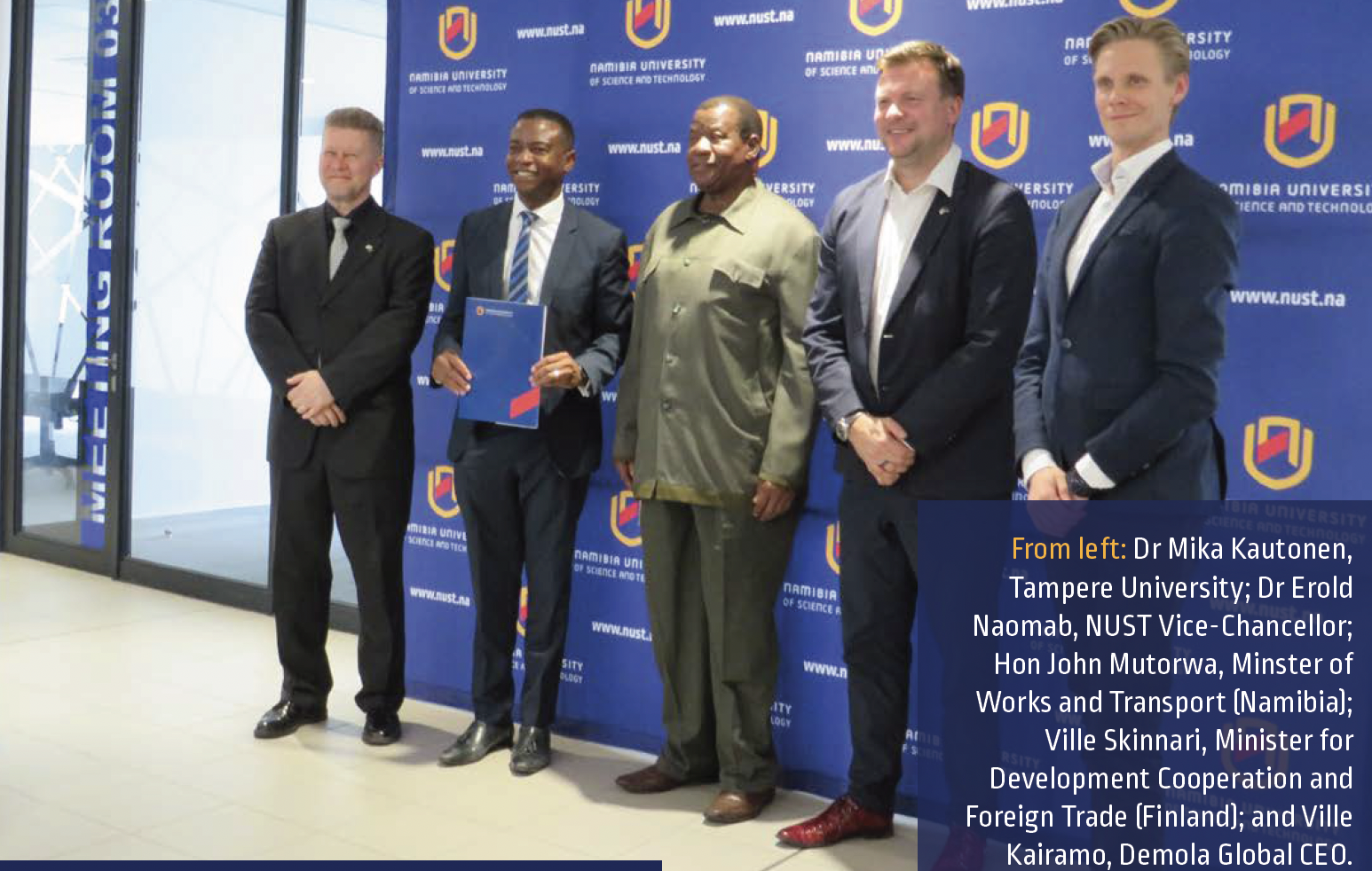
Honourable John Mutorwa, Member of Parliament and Namibia’s Minister of Works and Transport (MWT), appointed NUST as the coordinating agency in collaboration with the Tampere University for the feasibility study on the potential implementation of the CoE for African civil aviation in Namibia.
HTTPS, in partnership with Co-Creation Hub (CcHub), launched an Innovation Challenge aimed at supporting the development of innovative IoT solutions for sector-specific challenges in Namibia. The Innovation Challenge gave students the opportunity to take part in engaging sessions, aimed at creating innovative solutions in three key sectors: Water, Energy and Agriculture. The Challenge was facilitated by Co-Creation Hub. The intention is to contribute to the Vision of Namibia to be a prosperous and industrialised nation, developed by Namibian human resources by 2030.
From a thorough 2-weeks ideation and prototyping boot camp to receiving in depth business support, the selected students created new or improved products, processes, services, and customer experiences.
Industry partners had multiple engagements with the selected participants to ensure the solutions meet their needs.
Four teams were selected to proceed to the pre-incubation stage. The pre-incubation programme commenced with two learning sessions delivered to date.
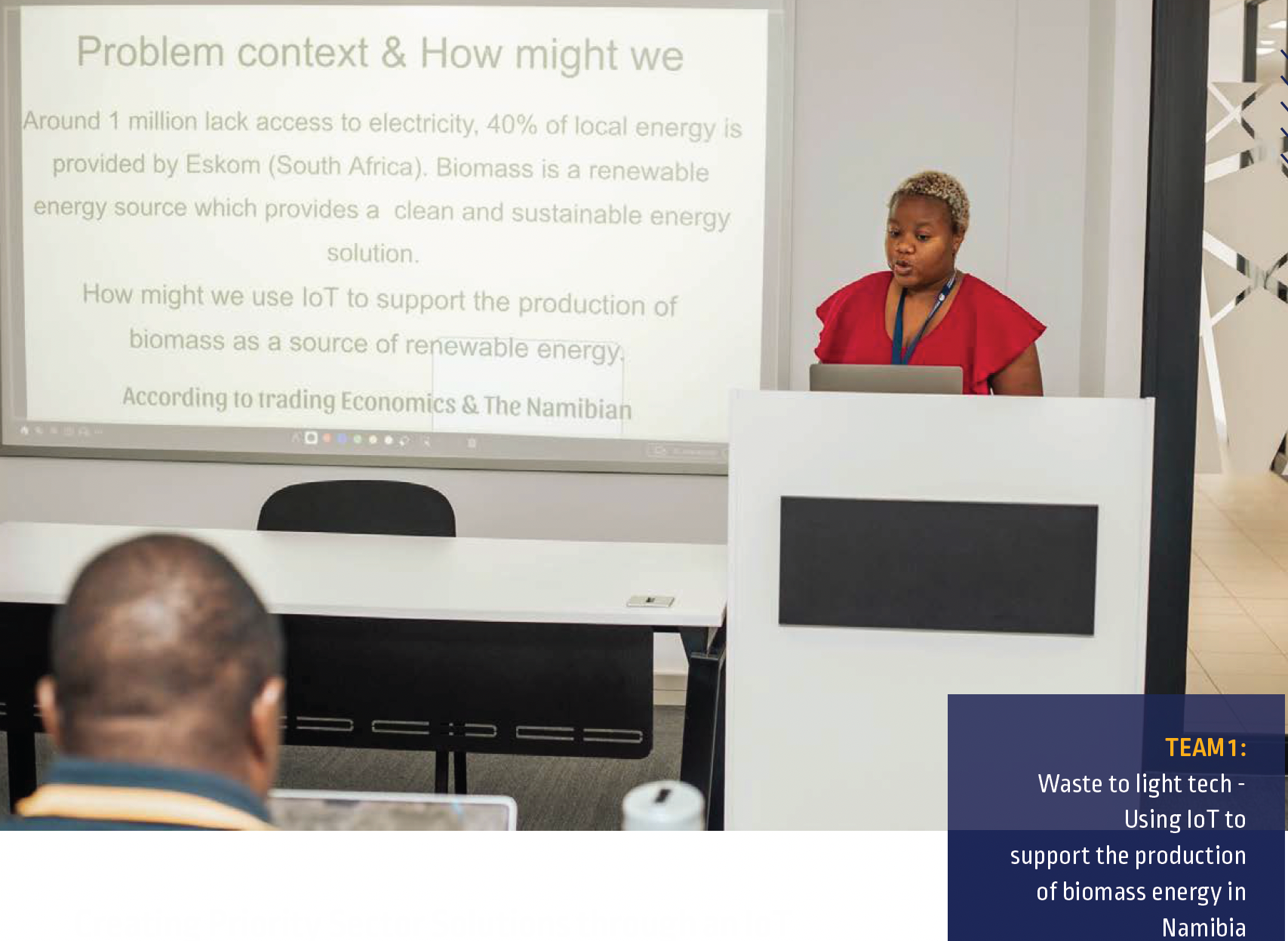
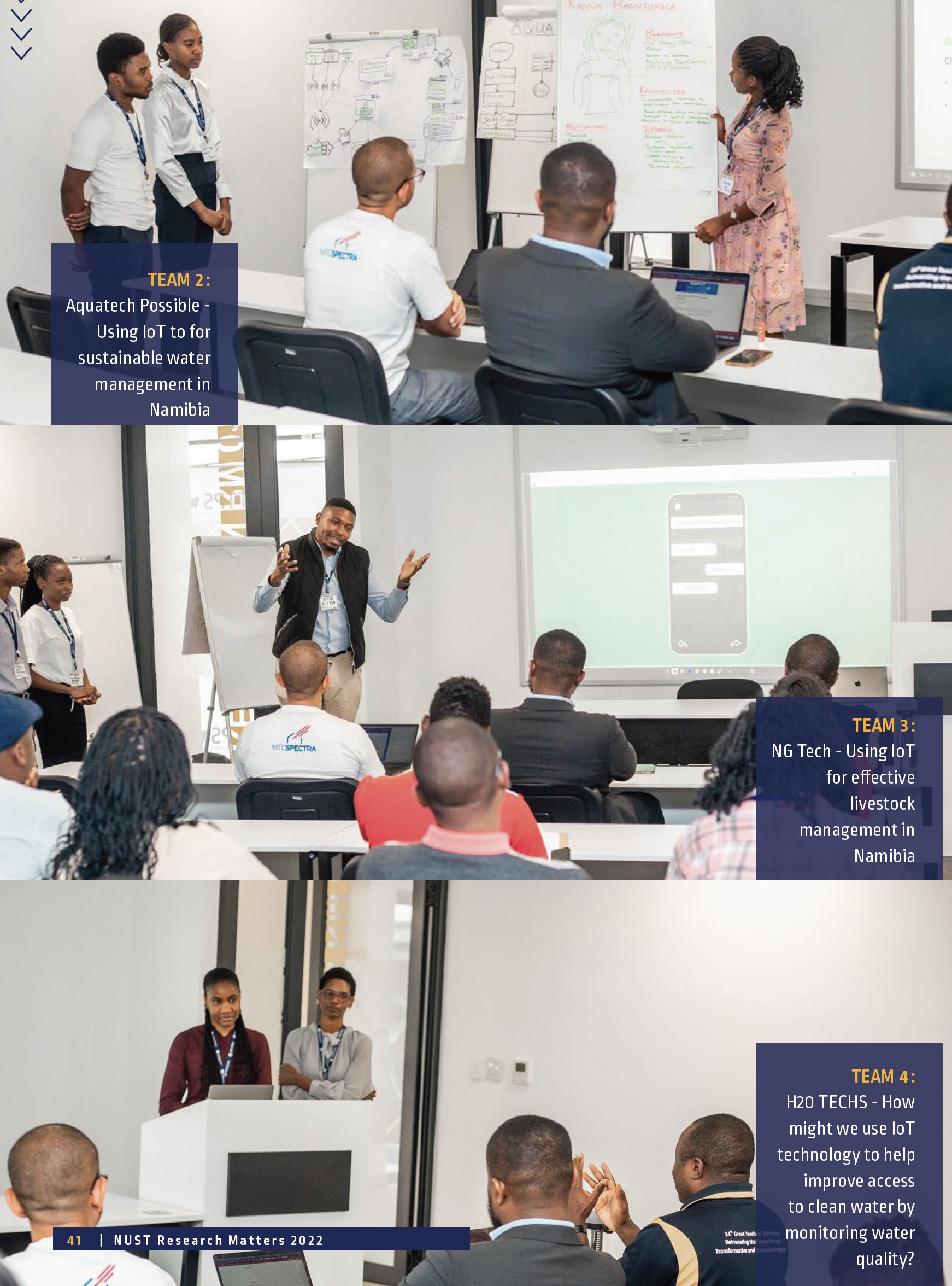
|
The Innovation Investment Readiness (IIR) week, co-organised by the Namibia Investment Promotion Development Board (NIPDB), NUST and MTC, provided a platform for government and private stakeholders to identify prototype projects that can increase their competitiveness and potential to attract investment. The event was attended by several high profile delegates inclusive of ministers and diplomats. By the end of the week, more than 50 investment-worthy projects were identified.
Creating Innovative SolutionsTelecom Namibia (TN), in partnership with the University held an Innovation Week on campus that saw students and staff from both institutions taking part in a hackathon to create innovative solutions that enhance the TN customer experience. The solutions were centred on, but not limited to; payments, service activation and ordering, fault reporting, theft prevention, and detection and customer engagement.
Regulatory Sandbox PotentialTogether with the Bank of Namibia and CChub, an African co-creation company, a financial technology summit was held for key players in the banking and education sectors and to broaden to share best practices in the evolution of digital financial services across the continent. A few recommendations from the summit included:
|
 |
There is a need for deliberate and concerted effort to focus on the institution’s collective product delivery in a predetermined manner to positively impact the economy. Consequently, NUST, is aiming at consolidating the management and coordination of innovation related activities. In this regard, the following strategies are considered:
- Enhance internal collaborations among centres, institutes and faculty in order to promote self-sufficiency, self-efficiency and achieve closed innovations by NUST.
- Strengthen existing collaborations-Create a forum of idea sharing for possible research topics and interest
- Implement cross-institutional short-term staff secondment/ exchange to identify synergy potential
- Develop joint proposals and engage in inter-disciplinary research and innovation projects, and,
- Identify roles of institutes to faculties in order to establish clear areas of collaboration.
This approach creates a strong, interlinked and sustainable innovation system, involving all the actors from academia to industry and civil society. Therefore, a coherent strategic approach of managing the development, application and commercialisation of scientific, technological and innovative knowledge needs to be created. This is important to stimulate a vibrant and coherent innovation system with clear benchmarking indicators. Market competition is an important driving force behind technological innovation while technological innovation is the ultimate route to enhanced enterprise competitiveness. To this end, the Institution will promote private-public research/innovation partnerships following the integrated steps of the Technology Transfer Cycle, with the ultimate aim of forging long term alliances.
Finally, there will be a drive to promote IP protection in order to facilitate the transfer of knowledge and create instruments for knowledge transfer, through the formalisation and approval of the NUST IP policy. Emphasis will be placed on support services and resources for nurturing start-up science and technology enterprises with the goal of developing them into financially viable businesses equipped with the tools for long-term survival and growth.
Dr Anna Matros-Goreses
Executive Director:
Directorate of Research, Innovation and Partnerships
Journal Articles
1. Amugongo, L. M., Green, A., Cobben, D., van Herk, M., McWilliam, A., & Osorio, E. V. (2022). Identification of modes of tumor regression in non‐small cell lung cancer patients during radiotherapy. Medical Physics, 49(1), 370-381.
2. Blessing G., Ambrose A., Sanjay M., Victor O., Luis Fernandez S. and Vera P. (2022). “The emerging Threat of AI-driven Attacks: A Review”. An International Journal of Applied Artificial Intelligence. Vol 36 Issue 1. Published by Taylor & Francis Ltd. DOI10.1080/08839514.2022.2037254
3. Farouk, A., Mumtaz, S., Singh Jat, D., Rathore, H., and Li, Z. (2022). Special Issue Computation and Modelling of Economic and Financial Complex SystemsDiscrete Dynamics in Nature and Society, vol. 2022. https://www.hindawi.com/journals/ddns/si/705941/page/2/
4. Guembe, B., Azeta, A., Misra, S., Osamor, V. C., Fernandez-Sanz, L., & Pospelova, V. (2022). The emerging threat of ai-driven cyber attacks: A review. Applied Artificial Intelligence, 36(1), 2037254.
5.Keskinen, P., Winschiers-Theophilus, H., Chivuno-Kuria, S., Müller A., and Nieminen, M. (2022). Digital microwork as a livelihood strategy in a Namibian informal settlement. Electron. J. Inf. Syst. Dev. Ctries. 88(1) (2022)
6.Khan, A., Milne-Ives, M., Meinert, E., Iyawa, G. E., Jones, R. B., & Josephraj, A. N. (2022). A scoping review of digital twins in the context of the Covid-19 pandemic. Biomedical Engineering and Computational Biology, 13, 11795972221102115.
7. Winschiers-Theophilus, H., Goagoses, N., Rötkönen, E., Zaman, T. (2022). Pushing political, cultural, and geographical boundaries: Distributed co-design with children from Namibia, Malaysia and Finland. International Journal on Child Computing. Interact. 31: 100439
8. Khan, A., Milne-Ives, M., Meinert, E., Iyawa, G. E., Jones, R. B., & Josephraj, A. N. (2022). A scoping review of digital twins in the context of the Covid-19 pandemic. Biomedical Engineering and Computational Biology, 13, 11795972221102115.
9. Osakwe, J., Iyawa, G., Ujakpa, M., & Mateus, J. (2022, May). Gamifying learning in high schools: Perceptions of students in selected African countries. In 2022 IST-Africa Conference (IST-Africa) (pp. 1-9). IEEE.
10. Osakwe, J., Waiganjo, I. N., Tarzoor, T., Iyawa, G., & Ujakpa, M. (2022, May). Determinants of information systems resources for business organisations’ competitive advantage: A resource-based view approach. In 2022 IST-Africa Conference (IST-Africa) (pp. 1-8). IEEE.
11. Keskinen, P., Winschiers‐Theophilus, H., Chivuno‐Kuria, S., Müller, A., & Nieminen, M. (2022). Digital microwork as a livelihood strategy in a Namibian informal settlement. The Electronic Journal of Information Systems in Developing Countries, 88(1), e12197.
12. Shilamba, M., Osakwe, J., Iyawa, G., & Ujakpa, 11. M. (2022, May). The use of electronic notification systems (e- Notification system) for registering births and deaths: Findings from a developing country. In 2022 IST-Africa Conference (IST-Africa) (pp. 1-8). IEEE.
13.Sitto, K., Lubinga, E., Chiumbu, S., Sobane, K. and Mpofu N. (2022). Evaluating government use of digital media during Covid-19 in Southern Africa. World Medical & Health Policy: 1-18
14. Ujakpa, M. M., Osakwe, J., Iyawa, G., Waiganjo, I., Hashiyana, V., & Simasiku, G. S. (2022, May). Development of the Greenwell Matongo community Library Management Information System (LMIS). In 2022 IST-Africa Conference (IST-Africa) (pp. 1-8). IEEE.
Book Chapters
1. Chiumbu, S., Mpofu N. & Sobane, K. (2022). Framing COVID 19: Fear appeal messaging in the print media in Namibia & South Africa. In C. A. Dralega & A. Napakol. (Eds). Covid-19 and the media in Sub-Saharan Africa: Media viability, framing and health communication. (pp. 99-114). Emerald Publishing.
2. Idemudia.E., Iyamu.T., Ndayizigamiye.P., Shaanika.I.(Eds.). (2022) Using Information Technology Advancements to Adapt to Global Pandemics. IGI Global (pp. 66-113).
3. Jain, A., & Jat, D. S. (2022). A review on consensus protocol of blockchain technology. In Intelligent Sustainable Systems: Selected Papers of WorldS4 2021, Volume 2. (pp. 813-829). Springer.
4. Meyer, M., Gamundani, A. M., Becker, K., Malpartida, D., Nugroho, A., Ochoa-Luna, J., Stanley, C., & Winschiers- Theophilus, H. (2022). Global Intercultural Project Experience (GIPE): A distributed interdisciplinary project-based learning. In M. Carmo (Ed.) Education Applications & Developments VII (pp. 187-205).inScience Press Framework.
Journal Articles
1. Angula, N. (2022). Transforming African education systems through the application of IoT. BOHR International Journal of Internet of things, Artificial Intelligence and Machine Learning, 1(1), 22-24. https://doi.org/10.54646/bijiotr.002
2. Angula, N., Schroeder, A., Beukes, L., Olivier, D., & Du Plessis, S. (2022). An Investigation into the impact of COVID-19 on the academic performance of students in higher education institutions in Namibia. BOHR International Journal of Financial Market and Corporate Finance, 2(1), 1-5. https://doi.org/10.54646/bijfmcf.011
3. Amushila, R., & Semente, E. M. M. (2022). Assessing the Degree of Women's Participation in the Logistics and Transport Industry in Namibia. International Journal of Applied Management Sciences and Engineering (IJAMSE), 9(1), 1-23.
4. Asa, R., Campbell, H., & Nautwima, J. (2022). A critical review of organizing knowledge management for innovation. International Journal of Management Science and Business Administration, 8(2), 7- 15.
5. Asa, R., & Nautwima, J. (2022). Determinants of financial capability: A situational analysis for Namibia. International Journal of Innovation and Economic Development, 7(6), 7-13.
6. Atiku, S. O., & Ganiyu, I. O. (2022). Flexible work options in higher educational institutions in times of crisis. SA Journal of Human Resource Management, 20, 1693.
7. Atiku, S. O., Kaisara, G., Kaupa, S., & Villet, H. (2022). Dimensions of learning organization: Implications for human resources effectiveness in commercial banks. Management Science Letters, 12(2), 117-124.
8. Baporikar, N. (2022). COVID-19 Pandemic's Socio-Economic Impact on SMEs. International Journal of Entrepreneurship and Governance in Cognitive Cities (IJEGCC), 3(1), 1-15.
9. Baporikar, N., & Musti, K. S. (2022). Strategic Perspective on Challenges and Opportunities in Big Data Management. International Journal of Big Data Intelligence and Applications (IJBDIA), 3(1), 1-15.
10. Baporikar, N. (2022). Tax education to enhance tax compliance for socio-economic development. International Journal of Sustainable Economies Management (IJSEM), 11(1), 1-28.
11. Baporikar, N. (2022). Innovation Management Case Study. International Journal of Innovation in the Digital Economy (IJIDE), 13(1), 1-11.
12. Baporikar, N. (2022). Performance Management System Implementation Challenges in State-Owned Enterprises. International Journal of Project Management and Productivity Assessment (IJPMPA), 10(1), 1-17.
13. Baporikar, N. (2022). Critical Success Factors for Timely Delivery of Road Construction Projects. International Journal of Applied Logistics (IJAL), 12(1), 1-24.
14. Baporikar, N., & Sauti, L. (2022). Social Enterprise Financing Case Study. International Journal of Information Systems and Social Change (IJISSC), 13(1), 1-18.
15. Baporikar, N. (2022). Tech Industries Pattern Case Study in Modern Society Based on Political Economy. International Journal of Applied Management Sciences and Engineering (IJAMSE), 9(1), 1-13.
16. Baporikar, N. (2022). Exploring Online Shopping Adoption for Innovations in Market Development. International Journal of Innovation in the Digital Economy (IJIDE), 13(1), 1-29.
17. Baporikar, N. (2022). Entrepreneurial University Challenges and Critical Success Factors to Thrive. International Journal of Applied Management Theory and Research (IJAMTR), 4(1), 1-15.
18. Baporikar, N. (2022). ICT Adoption Implications for SME Innovation and Augmentation. International Journal of Innovation in the Digital Economy (IJIDE), 13(1), 1-20.
19. Baporikar, N. (2022). Turnaround Strategy Implementation for Service Efficacy and Citizenry Satisfaction in Government Organizations. International Journal of Project Management and Productivity Assessment (IJPMPA), 10(1), 1-22.
20. Baporikar, N. (2022). Strategic framework for innovative tourism and sustainable development in Namibia. International Journal of Tourism and Hospitality Management in the Digital Age (IJTHMDA), 6(1), 1-16.
21. Cloete, G., Chiutsi, S., Ndlovu, J., & Prabhakaran, S. (2022). Defining the future of instruction in hospitality beyond Covid 19: A hybrid approach in higher education. International Journal of Academic Research in Business and Social Sciences, 12(1), 306-318.
22. Cloete, S., & Semente, E. M. M. (2022). The influence of in-store ambience on consumer purchasing behaviour: A Namibian retail apparel store case study. International Journal of Applied Management Sciences and Engineering (IJAMSE), 9(1), 1-10.
23. Cloete, G., Chiutsi, S., Ndlovu, J., & Prabhakaran, S. (2022). Defining the future of instruction in hospitality beyond Covid 19: A hybrid approach in higher education. International Journal of Academic Research in Business and Social Sciences, 12(1), 306-318.
24. de las Mercedes Barrachina, M., & Baporikar, N. (2022). Comparative Analysis of Factors Influencing Informal Investors of Spain and the United States. International Journal of Applied Behavioral Economics (IJABE), 11(1), 1- 14.
25. Dlamini, T. M., Ogunlela, O. O., Iwu, C. G., & Baporikar, N. (2022). Business Incubation Initiatives' Impacts on Entrepreneurs and SMEs. International Journal of E-Entrepreneurship and Innovation (IJEEI), 12(1), 1-21.
26. Dzingirai, M., & Baporikar, N. (2022). Financial Restructuring and Commercial Banks Performance Nexus in Zimbabwe. International Journal of Corporate Finance and Accounting (IJCFA), 9(1), 1-13.
27. Dzingirai, M., & Baporikar, N. (2022). Understanding Top Management Teams' Characteristics for Effective Turnaround Management: Evidence From the Zimbabwean Manufacturing Sector. International Journal of Sociotechnology and Knowledge Development (IJSKD), 14(1), 1-14.
28. Henok, W., & Kaulihowa, T. (2022). The impact of FDI on human capital development in SACU countries. International Journal of Social Economics, 49(2), 268-279.
29. Jeremiah, A., Atiku, S. O., Ochurub, M., Shimaneni, F., & Kandjinga, E. Predictive Influence of Petty Corruption on Operations of Southern African Universities.
30. Junias, K., Kambeyo, L., & Katukula, K. M. (2022) An analysis of a teacher education programme at a Namibian tertiary institution. Creative Education, 13, 2635-2657. https://doi.org/10.4236/ce.2022.138168
31. Kaisara, G., Atiku, S. O., & Bwalya, K. J. (2022). Structural Determinants of Mobile Learning Acceptance among Undergraduates in Higher Educational Institutions. Sustainability, 14(21), 13934.
32. Kakuru, C. & Kaulihowa, T. (2022). Determinants of house price dynamics and household indebtedness in Namibia. Studies in Economics and Econometrics, 46(3), 185-200.
33. Krishnamurthy, S. (2023). “Dismantling English: A case for the adoption of indigenous languages in Namibia” in Teaching English Writing in the Diaspora: Scaffolding Educators and Students. Editors Kalpana Mukunda Iyengar, Ph.D., & Howard L. Smith, Ph.D. USA: Sterling Publishers.
34. Krishnamurthy, S. (2022). Multi-lingual Education policy for Namibia: A case for endangered indigenous languages in Language Policy and Education in the SADC-region: A comparative perspective, Editors Russell H. Kaschula, Michael M. Kretzer, Rhodes University. Brill.
35. Krishnamurthy, S. (2022). Exploring Herero Genocide Survivor Narratives by Sarala Krishnamurthy and Alexandra Tjiramanga in Writing Namibia Coming of Age. Windhoek: UNAM press. (2022).
36. Krishnamurthy, S. (2022). Herero-Nama genocide as historical fiction: A New Historical analysis of Mama Namibia, The Scattering, and The Lie of the Land in Writing Namibia Coming of Age by Festus Abiatar and Sarala Krishnamurthy. Windhoek: UNAM press. (2022)
37. Krishnamurthy, S. (2022). Catharsis in Namibian women’s autobiography in Writing Namibia Coming of Age by Magdalena Cloete and Sarala Krishnamurthy. Windhoek: UNAM press. (2022)
38. Krishnamurthy, S. (2022). Interrogating the narrative “#Men Are Trash” in Namibian women’s spoken poetry with a focus on Gender Based Violence in Writing Namibia Coming of Age by Frieda Mukufa and Sarala Krishnamurthy. Windhoek: UNAM press. (2022)
39. Kaulihowa, T. (2022). Trade finance and policy uncertainty in Africa: Towards optimizing the benefits of Afreximbank pan-African payment and settlement system. Journal of African Union Studies, 11(2), 7-18.
40. Masake, P.H., & Irionya, R. (2022). Global Pandemics and the Challenge of Peace and Security in Africa: A focus on Covid-19 (Legal and Security Policy). Lexington Publisher.
41. Mncube, Z. & Kaulihowa, T. (2022). Financial innovation & income inequality in upper middle-income countries. African Journal of Development Studies, 12(3), 83-103.
42. Randa, I. O., & Baporikar, N. (2022). Collaborative Governance Contribution for Improving Post-Crash Responsiveness at Motor Vehicle Accident Fund. International Journal of Sustainable Economies Management (IJSEM), 11(1), 1-25.
43. Randa, I. O., & Baporikar, N. (2022). Alternative Building Technologies as a Delivery Mechanism for Affordable Housing. International Journal of Urban Planning and Smart Cities (IJUPSC), 3(1), 1-27.
44. Randa, I. O. (2022). Value Added Tax Administration and its Implications for Tax Performance. International Journal of Sustainable Economies Management (IJSEM), 11(1), 1-24.
45. Baporikar, N., & Randa, I. O. (2022). Graduate Development Program as an Interventional Strategy for Talent Management. International Journal of Applied Management Sciences and Engineering (IJAMSE), 9(1), 1-21.
46. Sheyapo, M., & Green, I. (2021, December) Curbing exclusion: The experiences of students with visual impairments and their lecturers on distance and
Book Chapters
1. Atiku, S. O., & Anane-Simon, R. (2022). Stimulating Creativity and Innovation through Apt Educational Policy. In Achieving Sustainability Using Creativity, Innovation, and Education: A Multidisciplinary Approach (pp. 113- 133). IGI Global.
2. Baporikar, N., & Baragde, D. B. (2022). Exploring Challenges and Opportunities for the Sustainability of Indian Information Technology. Handbook of Research on Organizational Sustainability in Turbulent Economies, 55- 71.
3. Baporikar, N. (2022). International Human Resource Management Strategies for Multicultural Organizations. In Research Anthology on Human Resource Practices for the Modern Workforce (pp. 1666-1687). IGI Global.
4. Baporikar, N. (2022). Public-Private Partnership for Urban Housing Through Civic Engagement. In Research Anthology on Citizen Engagement and Activism for Social Change (pp. 262-284). IGI Global.
5. Baporikar, N. (2022). Role of Microfinance in Entrepreneurship Development. In Microfinance and Sustainable Development in Africa (pp. 27-53). IGI Global.
6. Baporikar, N. (2022). Strategies to Manage and Preserve Indigenous Knowledge. In Handbook of research on protecting and managing global indigenous knowledge systems (pp. 207-222). IGI Global.
7. Baporikar, N. (2022). Trends for business education post covid-19. In Handbook of Research on Emerging Business Models and the New World Economic Order (pp. 287-303). IGI Global.
8. Baporikar, N. (2022). Preventing academic misconduct: student-centered teaching strategies. In Research Anthology on Interventions in Student Behavior and Misconduct (pp. 614-626). IGI Global.
9. Green, I., & Saarinen, J. (2022). Changing environment and the political ecology of authenticity in heritage tourism: A case of the Ovahimba and the Ju/’Hoansi-San Living Museums in Namibia. In Southern African perspectives on sustainable tourism Management: Tourism and changing localities (pp. 139-152). Springer International Publishing.
10. Hanekom, M. (2022). More freedom for the media: An appraisal of Trustco Group International Ltd and Others v Shikongo (SA-2009/8) [2010] NASC 6 (07 July 2010). In Warikandwa, T.V. & Baloro, J. (Eds.), Namibia’s Supreme Court at 30 Years: A Review of the Superior Court’s Role in the Development of Namibia’s Jurisprudence in the Post-Independence Era. (pp. 334-357). Konrad Adenauer Foundation.
11. Kaulihowa, T., Nyambe J. M. & Undji V. (2022). Recent history. In Europa Publications (Ed.), Africa South of the Sahara 2023 (52nd ed.). Routledge.
12. Masake, P. H. & Libebe, E. L. (2021). Decolonisation of legal education (miseducation and ignorance): Excerpts from Afrocentric perspectives in Southern Africa. In Nhemachena, A., Chitimira, H. T. & Warikandwa, T. V. (Eds.), Global jurisprudential apartheid in the twenty-first century: Universalism and particularism in international law (pp. 85-105). Rowman & Littlefield.
13. Masake, P.H. (2022). The role of the Supreme Court of Namibia in demystifying transnational corporations’ accountability for international crimes. In Warikandwa, T.V. & Baloro, J. (Eds.), Namibia’s Supreme Court at 30 Years: A Review of the Superior Court’s Role in the Development of Namibia’s Jurisprudence in the Post- Independence Era. (pp. 198-224). Konrad Adenauer Foundation.
14. Peel, C; Hamalwa, AM, & Kaisara, G (2022) Public Procurement and Stakeholders: Assessing Namibia’s Consultative Processes and Challenges. In I. Tshabangu (Ed.) Interdisciplinary Approaches to the Future of Africa and Policy Development. (pp.137-149). https://doi.org/10.4018/978-1-7998-8771-3.ch008
15. Randa, I. O. (2022). Integrated Reporting for Inclusive and Sustainable Global Capitalism. In Handbook of Research on Global Institutional Roles for Inclusive Development (pp. 175-197). IGI Global.
16. Schutz, S., & Hijarunguru, N. (2022). Law-making on the fault lines of Constitutional supremacy, separation of powers and democracy. In Warikandwa, T.V. & Baloro, J. (Eds.), Namibia’s Supreme Court at 30 Years: A Review of the Superior Court’s Role in the Development of Namibia’s Jurisprudence in the Post-Independence Era. (pp. 198-224). Konrad Adenauer Foundation.
17. Semente, E. M. M. (2022). Learning styles influence on consumer decision-making styles of Generation Y consumers in Namibia: A comparison study of the three major universities in Namibia. In Fundamentals in effective marketing. CARI Journals.
Book Chapters
1.Baporikar, N. (Ed.). (2023). Governance as a Catalyst for Public Sector Sustainability. IGI Global. https://doi.org/10.4018/978-1-6684-6966-8
2.Baporikar, N. (Ed.). (2023). Leadership and Governance for Sustainability. IGI Global. https://doi.org/10.4018/978-1-6684-9711-1
3.Krishnamurthy, S. Mlambo, N. & Vale, H. (2022). Writing Namibia Coming of Age
Basel: Basler Afrika Bibliographien.
Journal Articles
1. Ajayi, O. G., Nwadialor, I. J., Odumosu, J. O., Adetunji, O. O., and Abdulwasiu, I. O. (2022). Assessment and delineation of groundwater potential zones using integrated geospatial techniques and analytic hierarchy process. Applied Water Science, 12(276). https://doi.org/10.1007/s13201-022-01802-4
2. Ajayi, O. G., and Ashi, J. (2022). Effect of varying training epochs of faster region-based convolutional neural network on the accuracy of an automatic weed classification scheme. Smart Agricultural Technology, 3(2023). https://doi.org/10.1016/j.atech.2022.100128
3. Ajayi, O. G., Opaluwa, Y. D., Ashi, J. and Zikirullahi, W.M. (2022). Applicability of artificial neural network for automatic crop type classification on UAV-based images. Environmental Technology and Science Journal, 13(1), 57-72. https://doi.org/10.4314/etsj.v13i1.5
4. Ajayi, O. G., and Oruma, E. (2022). On the applicability of integrated UAV photogrammetry and automatic feature extraction for cadastral mapping. Advances in Geodesy and Geoinformation (formerly Geodesy and Cartography), 71(1). https://doi.org/10.24425/gac.2022.141172
5. Ajayi, O. G., and Ojima, A. (2022). Performance evaluation of selected cloud occlusion removal algorithms on remote sensing imagery. Remote Sensing Applications: Society and Environment, 25, 1-17. https://doi.org/10.1016/j.rsase.2022.100700
6. Adesina, E. A., Musa, A., Ajayi, O. G., Odumosu, J. O., Opaluwa, Y. D., Onuigbo, I. C. (2022). Comparative assessment of SRTM and UAV-Derived DEM in flood modelling. Environmental Technology and Science Journal, 12(2), 58-70. https://doi.org/10.4314/etsj.v12i2.6
7. Ashi, J., Ajayi, O. G., Waliu, Z. M. (2022, March). Automatic crop type classification on UAV-based images using artificial neural network. 3rd National Association of Surveying and Geoinformatics Lecturers
8. Ajayi, O. G., and Oruma, E. (2022). Integrated UAV-photogrammetry and automatic feature extraction for cadastral mapping. A featured article published in Coordinates, XVIII(10 & 11).
9. Ajayi, O. G., Nwadialor, I. J., Odumosu, J. O., Adetunji, O. O., and Abdulwasiu, I. O. (2022). Assessment and delineation of groundwater potential zones using integrated geospatial techniques and analytic hierarchy process. Applied Water Science, 12(276). https://doi.org/10.1007/s13201-022-01802-4.
10. Adamu, B. Mabakeng, M. & Youngu, Y. (2022, September). Corruption of Land Administration in Sub-Saharan Africa: Reports from Nigeria and Namibia. International Federation of Surveyors Congress, 11-15 September, Warsaw, Poland.
11. Adewunmi, Y., ChIgbu U.E., Mwando, S and Kahireke, U. (2022). Entrepreneurship role in the co-production of public services in informal settlements - A scoping review. Land Use Policy, 125, 106479.
12. Chigbu, U.E. (2022, September). Urban-rural land linkages: Concept explained using 'continuum' theory and metaphor. International Federation of Surveyors Congress, 11-15 September, Warsaw, Poland.
13. Chigbu, U.E., Klaus, M. and Zhang, W. (2022, September). Aiming at a better impact of the land professions: the role of academic and policy dialogues. International Federation of Surveyors Congress, 11-15 September, Warsaw, Poland.
14. Chigbu, U.E., Klaus, M. and Zhang, W. (2022, September). Aiming at a better impact of the land professions: the role of academic and policy dialogues. International Federation of Surveyors Congress, 11-15 September, Warsaw, Poland.
15. Chigbu, U.E., Mabakeng, M.R., Alexander, L., Siukuta, M., Simataa, V. and Ricardo, P. (2022, September). Tenure-restoration nexus for local action in Africa: Identifying customary enablers and disablers of tenure in land restoration. International Federation of Surveyors Congress, 11-15 September, Warsaw, Poland.
16. Chigbu, U.E. and Klaus, M. (2022, September). Rural revitalisation — a key to urban-rural land linkages. International Federation of Surveyors Congress, 11-15 September, Warsaw, Poland.
17. Negussie, K. G., Wyss, D., Knox, N., Vallejo Orti, M., Corral-Pazos-de-Provens, E., & Kappas, M. (2022). Evaluating SWAT model for streamflow estimation in the semi-arid Okavango-Omatako catchment, Namibia. African Journal of Environmental Science and Technology, 16(11), 385-403.
18. Kohima, M. J., Chigbu, U. E., Mazambani, M. L. and Mabakeng, M. R. (2022). (Neo-)segregation, (neo-)racism, and one-city two-system planning in Windhoek, Namibia: What can a new national urban policy do? Land Use Policy, 125, 106480.
19. Magel, H. and Chigbu, U.E. (2022). Urban-rural land linkages and territorial justice as states of mind. GeoConnexion International Magazine, 21(2), pp. 32-33.
20. Mabakeng, M. Kohima, J. Ricardo, P. Simataa, V. Alexander, L. (2022, September). The emergence of Namibia Openstreetmap community, supporting GIS data generation for informal settlements. International Federation of Surveyors Congress, 11-15 September, Warsaw, Poland.
21. Mwando, S. (2022). Smallholder Farmer Empowerment and Neoliberalism: Examining the Current Institutional and Policy Arrangements in Zambia. In F. Mazwi, Mudimu, G. T., &Helliker, K. (Eds.), Capital Penetration and the Peasantry in Southern and Eastern Africa: Neoliberal Restructuring (pp. 141-161). Cham: Springer International Publishing.
22. Chigara, B., & Moyo, T. (2022). Factors affecting the delivery of optimum health and safety on construction projects during the covid-19 pandemic in Zimbabwe. Journal of engineering, design and technology, 20(1), 24-46.
23. Kandjinga, L., & Landman, K. (2022). Planning for safe neighbourhoods in Namibia: A comparative case study of two low-income neighbourhoods in the city of Windhoek. Development Southern Africa, 40(4), 771-790.
24. Moyo, T., Crafford, G., & Emuze, F. (2022). Sustainability learning for improved safe work environments for construction semi-skilled workers in Zimbabwe. Built Environment Project and Asset Management, 12(6), 940- 955.
25. Tjipetekera, C., Gumbo, T. & Yankson, E. (2022). Analysing the causes and challenges of urban spatial expansion in Windhoek, Namibia: Towards sustainable urban development strategy. In Schrenk, M., Popovich, V. V., Zeile, P., Elisei, P., Beyer, C. & Ryser, J. (Eds.) 27th International Conference on Urban Planning and Regional Development in the Information Society (Real Corp).
26. loete,G., Benito, G, Grodek, T., Porat, N., Hoffman, J., & Enzel, Y. (2022). Palaeoflood records to assist in design of civil infrastructure in ephemeral rivers with scarce hydrological data: Ugab River, Namibia. Journal of Hydrology: Regional Studies, 44, 101263. https://doi.org/10.1016/j.ejrh.2022.101263
27. Iyama W.A, Nimame, P, Nwagbara V.U, Timothy M.N, Egbunefu C.O, & Emerjuru W.S (2023). Risk assessment of the impact of oil spill on the heavy metal content of Santa Barbara River in Bayelsa State, Nigeria. Research and Science and Today, 1(125), 89-108.
28. Katende, J. (2022, November 8). Off-grid power supply based on green hydrogen storage potential: A case study of the NUST SEED Living Lab at !Kharoxas” [Paper presentation]. NUST Institutional Research Week 2022 Windhoek, Namibia.
29. Nwagbara V.U, Chigayo K, Iyama W.A, and Kwaambwa M.K. (2022). Removal of lead, cadmium and copper from water using Moringa. Journal of Water and Climate Change, 13(7), 2747-2760.
Nwagbara V.U, Iyama W.A, Kayini C, and Kwaambwa H.M. (2022). Efficiency of Moringa Oleifera seed biomass in the removal of lead (II) ion in aqueous solution. European Journal of Applied Sciences, 10(2), 414-431.
30. Nwagbara V.U, Sika F.O, Iyama W.A, Chigayo K. and Kwaambwa H.M. (2022). Evaluating the Potential Effectiveness of Moringa Oleifera Seeds Biomass as an Adsorbent in the Removal of Copper (Cu) in Water. Journal of Geoscience and Environment Protection, 10(3), 120-143.
31. Perry, I., Jams, I.B., Casa-Mulet, R., Hamutoko, J., Marchbank, A., Lendolvo, S., Naomab, E., Mapani, B., Creer, S., Wanke, H., Durance, I., and Kille, P. (2022). Challenges in implementing Environmental – DNA Monitoring in Namibia. Frontiers in Environmental Science. 1-10.
Journal Articles
1. Bosch, C., Hauwanga, E., Omoruyi, B. E., Okeleye, B. I., Okudoh, V. I., & Aboua, Y. G. (2022). Effects of Population Knowledge, Perceptions, Attitudes, and Practices on COVID-19 Infection Prevention and Control in NUST. International Journal of Environmental Research and Public Health, 19(10), 5918. https://doi.org/10.3390/ijerph19105918
2. Conradie, W., Schmitz, A., Lobón-Rovira, J., Becker, F. S., Pinto, P. V., & Hauptfleisch, M. L. (2022). Rock island melody remastered: two new species in the Afroedura bogerti Loveridge, 1944 group from Angola and Namibia. Zoosystematics and Evolution, 98(2), 435-453. https://doi.org/10.3897/zse.98.86299
3. Cullis, C., Chimwamurombe, P., Kunert, K., & Vorster, J. (2022). Perspective on the present state and future usefulness of marama bean (Tylosema esculentum). Food & Energy Security, 12(2). https://doi.org/https://onlinelibrary.wiley.com/doi/10.1002/fes3.422
4. Sahu, D. R., Hung, C. Y., Wang, S. C., & Huang, J. L. (2022). Effects of a polystyrene intermediate layer for improved electrochromic properties of nano porous WO 3 electrochromic films. Materials Advances, 3(14), 6000- 6006. https://doi.org/10.1039/D2MA00476C
5. Dludla, P. V., Nkambule, B. B., Cirilli, I., Marcheggiani, F., Mabhida, S. E., Ziqubu, K., ... & Mazibuko- Mbeje, S. E. (2022). Capsaicin, its clinical significance in patients with painful diabetic neuropathy. Biomedicine & Pharmacotherapy, 153, 113439. https://doi.org/10.1016/j.biopha.2022.113439
6. Eegunjobi, A. S., & Makinde, O. D. (2022). Mathematical analysis of two strains Covid-19 disease using SEIR model. Journal of Mathematical & Fundamental Sciences, 54(2), 211–232. https://doi.org/10.5614/j.math.fund.sci.2022.54.2.1
7. Eegunjobi, A. S., & Makinde, O. D. (2023). Second law analysis of MHD convection of a radiating nanofluid within the gap between two inclined concentric pipes. International Journal of Modern Physics B, 37(16), 2350153. https://doi.org/10.1142/S0217979223501539
8. Shafodino, F. S., Lusilao, J. M., & Mwapagha, L. M. (2022). Phytochemical characterization and antimicrobial activity of Nigella sativa seeds. PLoS ONE, 17(8), 1–20. https://doi.org/10.1371/journal.pone.0272457
9. Hausiku, L., Kouame, K., & Aboua, Y. G. (2022). Perceptions and attitude of women of Luderitz, Namibia on Pap smear and cervical cancer prevention. BMC Women’s Health, 22(1). https://doi.org/10.1186/s12905-022-01698-x
10. Hering, R., Hauptfleisch, M., Jago, M., Smith, T., Kramer-Schadt, S., Stiegler, J., & Blaum, N. (2022). Don’t stop me now: Managed fence gaps could allow migratory ungulates to track dynamic resources and reduce fence related energy loss. Frontiers in Ecology and Evolution, 10. https://www.frontiersin.org/articles/10.3389/fevo.2022.907079
11. Kavishe, F. F., Chimwamurombe, P., & Kennedy, J. (2022). A survey of genetically modified foods and feed in Namibian supermarkets. Cognizance Journal of Multidisciplinary Studies, 2, 85–92. https://doi.org/10.47760/cognizance.2022.v02i08.003
12. Horn, L., Shakela, N., Mutorwa, M. K., Naomab, E., & Kwaambwa, H. M. (2022). Moringa Oleifera as a sustainable climate-smart solution to nutrition, disease prevention, and water treatment challenges: A review. Journal of Agriculture and Food Research, 10(100397-). https://doi.org/10.1016/j.jafr.2022.100397
13. Mahalie, R., Angula, P., Mitonga, K. H., & Oladimeji, O. (2022). Predictors of cardiovascular diseases among people living with HIV initiated on antiretroviral therapy in Khomas region, Namibia: A cross-sectional study. Journal of Public Health in Africa, 13(1). https://doi.org/https://www.publichealthinafrica.org/jphia/article/view/1561
14. Mutorwa, M. K., Lobb, K. A., Klein, R., Blatch, G. L., & Kaye, P. T. (2022). Synthesis of 2, 3-dihydroxy-3-(N-substituted carbamoyl) propylphosphonic acid derivatives as hybrid DOXP-fosmidomycin analogues. Journal of Molecular Structure, 1256, 132453. https://doi.org/10.1016/j.molstruc.2022.132453
15. Hitila, M. V., & Onjefu, S. A. (2021). Radiological risk assessment of technologically enhanced naturally occurring radioactive materials in coal wastes from Van Eck coal-rired thermal power plant, Namibia. Namibian Journal for Research, Science and Technology, 3(1), 21-29. https://doi.org/10.54421/njrst.v3i1.45
16. Mataranyika, P. N., Chimwamurombe, P. M., Venturi, V., & Uzabakiriho, J. D. (2022). Bacterial bioinoculants adapted for sustainable plant health and soil fertility enhancement in Namibia. Frontiers in Sustainable Food Systems, 6. https://doi.org/10.3389/fsufs.2022.1002797
17. Mthembu, S. X., Orlando, P., Silvestri, S., Ziqubu, K., Mazibuko-Mbeje, S. E., Mabhida, S. E., ... & Dludla, P. V. (2023). Impact of dyslipidemia in the development of cardiovascular complications: delineating the potential therapeutic role of coenzyme Q10. Biochimie, 204, 33-40. https://doi.org/10.1016/j.biochi.2022.08.018
18. Mthembu, S. X. H., Mazibuko-Mbeje, S. E., Ziqubu, K., Nyawo, T. A., Obonye, N., Nyambuya, T. M., Nkambule, B. B., Silvestri, S., Tiano, L., Muller, C. J. F., & Dludla, P. V. (2022). Impact of physical exercise and caloric restriction in patients with type 2 diabetes: Skeletal muscle insulin resistance and mitochondrial dysfunction as ideal therapeutic targets. Life Sciences, 297. https://doi.org/10.1016/j.lfs.2022.120467
19. Mxinwa, V., Nkambule, B. B., Nyambuya, T. M., & Dludla, P. V. (2022). Expression of Caspase-3 in circulating innate lymphoid cells subtypes is altered by treatment with Metformin and Fluvastatin in high-fat diet fed C57BL/6 mice. Cells (2073-4409), 11(9), N.PAG. https://doi.org/10.3390/cells11091430
20. Nepolo, E. P., Nkambule, B. B., Dludla, P. V., Ndevahoma, F., & Nyambuya, T. M. (2022). Association between the type of allergen and T-helper 2 mediated inflammation in allergic reactions: a systematic review and a meta-analysis. Allergologia et Immunopathologia, 50(1), 37-50. https://doi.org/10.15586/aei.v50i1.470
21. Ntamo, Y., Jack, B., Ziqubu, K., Mazibuko-Mbeje, S. E., Nkambule, B. B., Nyambuya, T. M., ... & Dludla, P. V. (2022). Epigallocatechin gallate as a nutraceutical to potentially target the metabolic syndrome: Novel insights into therapeutic effects beyond its antioxidant and anti-inflammatory properties. Critical Reviews in Food Science and Nutrition, 1-23. https://doi.org/10.1080/10408398.2022.2104805
22. Nkambule, B. B., Mxinwa, V., Nyambuya, T. M., & Dludla, P. V. (2022). The mean platelet volume and atherosclerotic cardiovascular-risk factors in adults with obesity: a systematic review and meta-analysis of observational studies. BMC nutrition, 8(1), 1-13. https://doi.org/10.1186/s40795-022-00541-8
23. Nwagbara, V. U., Iyama, W. A., Kayini, C., & Kwaambwa, H. M. (2022). Efficiency of Moringa Oleifera seed biomass in the removal of lead (II) ion in aqueous solution. European Journal of Applied Sciences, 10(2), 414-431. https://doi.10.14738/aivp.102.11706
24. Ngcobo, S. R., Nkambule, B. B., Nyambuya, T. M., Mokgalaboni, K., Ntsethe, A., Mxinwa, V., Ziqubu, K., Ntamo, Y., Nyawo, T. A., & Dludla, P. V. (2022). Activated monocytes as a therapeutic target to attenuate vascular inflammation and lower cardiovascular disease-risk in patients with type 2 diabetes: A systematic review of preclinical and clinical studies. Biomedicine & Pharmacotherapy, 146. https://doi.org/10.1016/j.biopha.2021.112579
25. Nyawo, T. A., Dludla, P. V., Mazibuko-Mbeje, S. E., Mthembu, S. X. H., Nyambuya, T. M., Nkambule, B. B., Sadie-Van Gijsen, H., Strijdom, H., & Pheiffer, C. (2022). A systematic review exploring the significance of measuring epicardial fat thickness in correlation to B-type natriuretic peptide levels as prognostic and diagnostic markers in patients with or at risk of heart failure. Heart Failure Reviews, 27(2), 665–675. https://doi.org/10.1007/s10741-021-10160-3
26. Onjefu, S. A., Wilika, N. P., Hitila, M., Kamunda, C., Hamunyela, R. H., Asuquo, S. O., Ejembi, E., Mutorwa, M. K., & Euodia, H. H. (2022). Determination of Natural Radioactivity in Nuts and Seeds and their Radiological Implications in the Human Body. Nigerian Annals of Pure and applied Sciences, 5(1), 207–214. https://doi.org/10.5281/zenodo.7055341
27. Onjefu, S. A., Johannes, N. N., Abah, J., Onjefu, L. A., & Mwiya, S. (2022). Natural radioactivity levels and evaluation of radiological hazards in Usakos marble, Erongo region, Namibia. International Journal of Radiation Research, 20(2), 403-409.http://doi.org/10.52547/ijrr.20.2.22
28. Sapana, S, Kumar, R, Soodan, B. S. and Singh, P. (2022). Queuing models with customers’ impatience: A survey. International Journal of Mathematics in Operational Research. http://doi.org/10.1504/IJMOR.2022.10052442
29. Sobantu, M. P., Okeleye, B. I., Okudoh, V. I., Meyer, M., & Aboua, Y. G. (2022). In vitro antioxidant mechanism of action of Hibiscus Sabdariffa in the induction of apoptosis against breast cancer. Journal of Herbs, Spices & Medicinal Plants, 29(3), 213-228. https://doi.org/10.1080/10496475.2022.2135661
30. Siseho, K. N., Omoruyi, B. E., Okeleye, B. I., Okudoh, V. I., Amukugo, H. J., & Aboua, Y. G. (2022). Women’s perception of cervical cancer pap smear screening. Nursing Open, 9(3), 1715-1722. https://doi.org/10.1002/nop2.1196
31. Swanepoel, W., Becker, R., De Cauwer, V., & Van Wyk, A. E. (2022). Senecio namibensis (Asteraceae: Senecioneae), a new species from Namibia. Phytotaxa, 571(2), 103-111. https://doi.org/10.11646/phytotaxa.571.2.1
32. Onjefu, S. A., Kauluma, A. N. I., Zivuku, M., Ejembi, E., Hamunyela, R. H., & Tyobeka, B. M. (2022). Assessment of radioactivity levels in shore sediments along the coastline of the Orange River, Oranjemund, Namibia. Heliyon, 8(9). http://doi.org/10.1016/j.heliyon.2022e10579
33. Obuseng, V. C., Moshoeshoe, M. N., Nareetsile, F. M., Kwaambwa, H., & Maina, I. (2022). Plant biomass as potential economic commodities for agricultural purposes. Frontiers in chemistry, 10, 806772. https://doi.org/10.3389/fchem.2022.806772
34. Nwagbara, V. U., Chigayo, K., Iyama, W. A., & Kwaambwa, H. M. (2022). Removal of lead, cadmium, and copper from water using Moringa oleifera seed biomass. Journal of Water and Climate Change, 13(7), 2747-2760. https://doi.10.2166/wcc.2022.091
35. Wildermuth, B., Oldeland, J., Arning, C., Gunter, F., Strohbach, B., & Juergens, N. (2022). Spatial patterns and life histories of Macrotermes michaelseni termite mounds reflect intraspecific competition: insights of a temporal comparison spanning 12 years. Ecography, 2022(9). https://doi.org/10.1111/ecog.06306
36. Zeriapi, I., & Awofolu, O. R. (2022). Environmental, socio-economic, and human health impact of illegal waste disposal in Katutura township of Namibia. International Journal of Environment and Waste Management, 29(2), 179-195. https://doi.org/10.1504/IJEWM.2022.121210
Books
1. Gabriel, N. N., Omoregie, E., & Abasubong, K. P. (Eds.). (2023). Emerging sustainable aquaculture innovations in Africa. Springer.
Book Chapters
1. Omoregie, E. (2022). African aquaculture: Enhancement of aater quality for sustainable freshwater finfish culture. In N.N. Gabriel, E. Omoregie, and K. Prudence (Eds). Emerging Sustainable Aquaculture Innovations in Africa (pp. 341-363). Springer Nature.
2. Hauptfleisch, M.L. (2022). A conservation assessment of Honey Badger Mellivora capensis. In J. Pallett, & G. Potgieter (Eds). Conservation Status and Red List of Carnivores in Namibia. Namibian Chamber of Environment & LCMAN.
3. Hauptfleisch, M.L. (2022). A conservation assessment of Rusty-spotted Genet Genetta maculata. In J. Pallett, & G. Potgieter (Eds). Conservation Status and Red List of Carnivores in Namibia. Namibian Chamber of Environment & LCMAN.
4. Hauptfleisch, M.L. (2022). A conservation assessment of Small-spotted Genet Genetta genetta. In J. Pallett, & G. Potgieter (Eds). Conservation Status and Red List of Carnivores in Namibia. Namibian Chamber of Environment & LCMAN.
5. Haikera, H. K., Aku-Akai, L., & Aboua, Y. G. (2022). Scope of Medicinal Plants for Uterotonic, Tocolytic, and Wellness Effects in Pregnant Women: A Cultural Perspective. In M.h.R. Goyal, J. A. Malik, and A. O. AyelesoCurative and Preventive Properties of Medicinal Plants: Research on Disease Management and Animal Model Studies (341).
6. Kumar, R., Sharma, S., & Soodan, B. S. (2022). Multi-server queuing system with feedback and retention. In M. Jain, D. K. Sharma, R. Kulshrestha, and H.S. Hot (Eds). Applications of Mathematical Modeling, Machine Learning, and Intelligent Computing for Industrial Development (pp. 77-91). Routledge.
7. Kumar, R., Som, B. K., Kalidass, K., & Sampath, M. S. (2023). Queuing system with customers' impatience, retention, and feedback. In M. Jain , D. K. Sharma, R. Kulshrestha, & H.S. Hota (Eds.), Applications of Mathematical Modeling, Machine Learning, and Intelligent Computing for Industrial Development (pp. 49-59). Taylor & Francis Group.


